Financial Accounting Principles - Assignment
VerifiedAdded on 2020/12/30
|37
|4664
|305
AI Summary
Contribute Materials
Your contribution can guide someone’s learning journey. Share your
documents today.
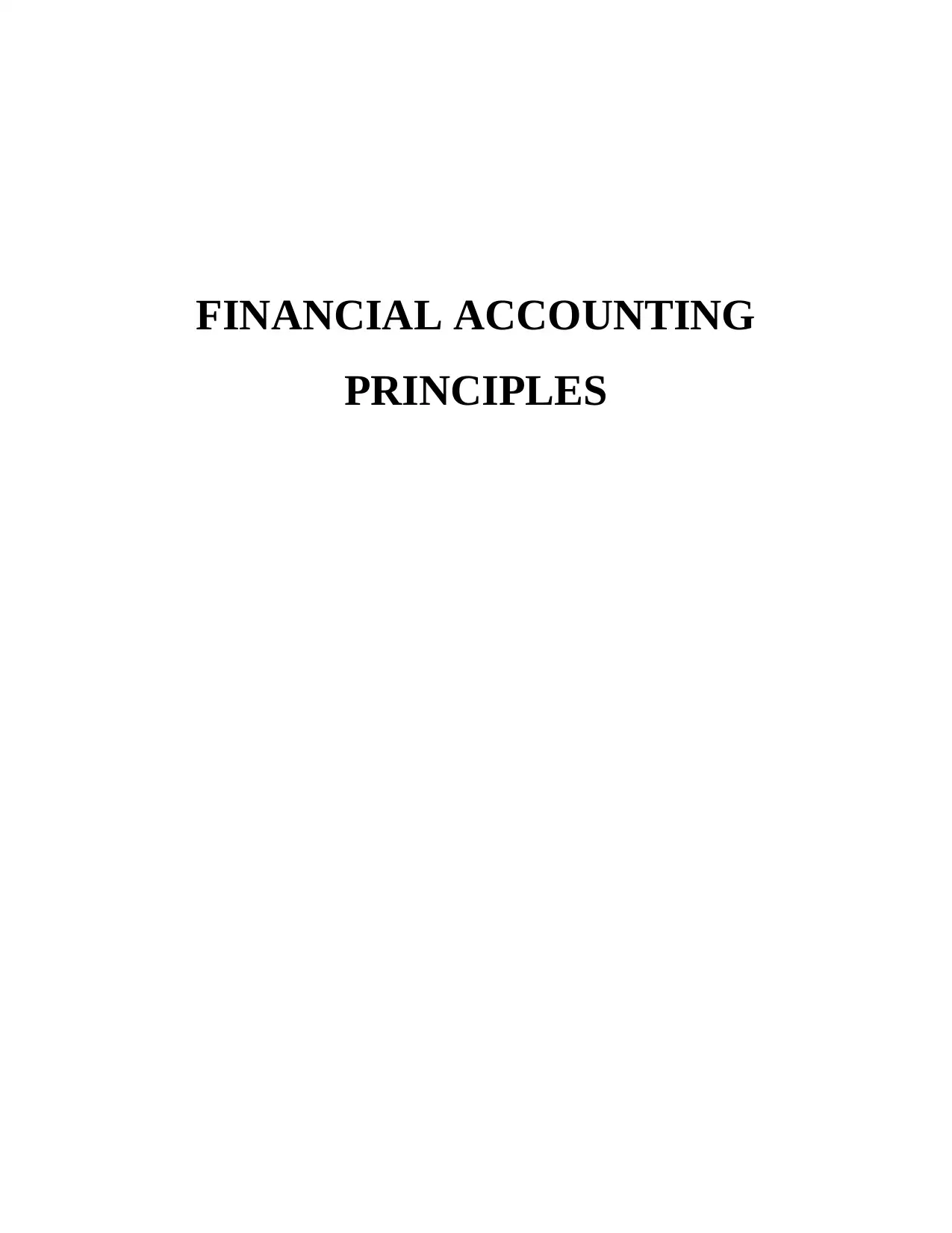
FINANCIAL ACCOUNTING
PRINCIPLES
PRINCIPLES
Secure Best Marks with AI Grader
Need help grading? Try our AI Grader for instant feedback on your assignments.
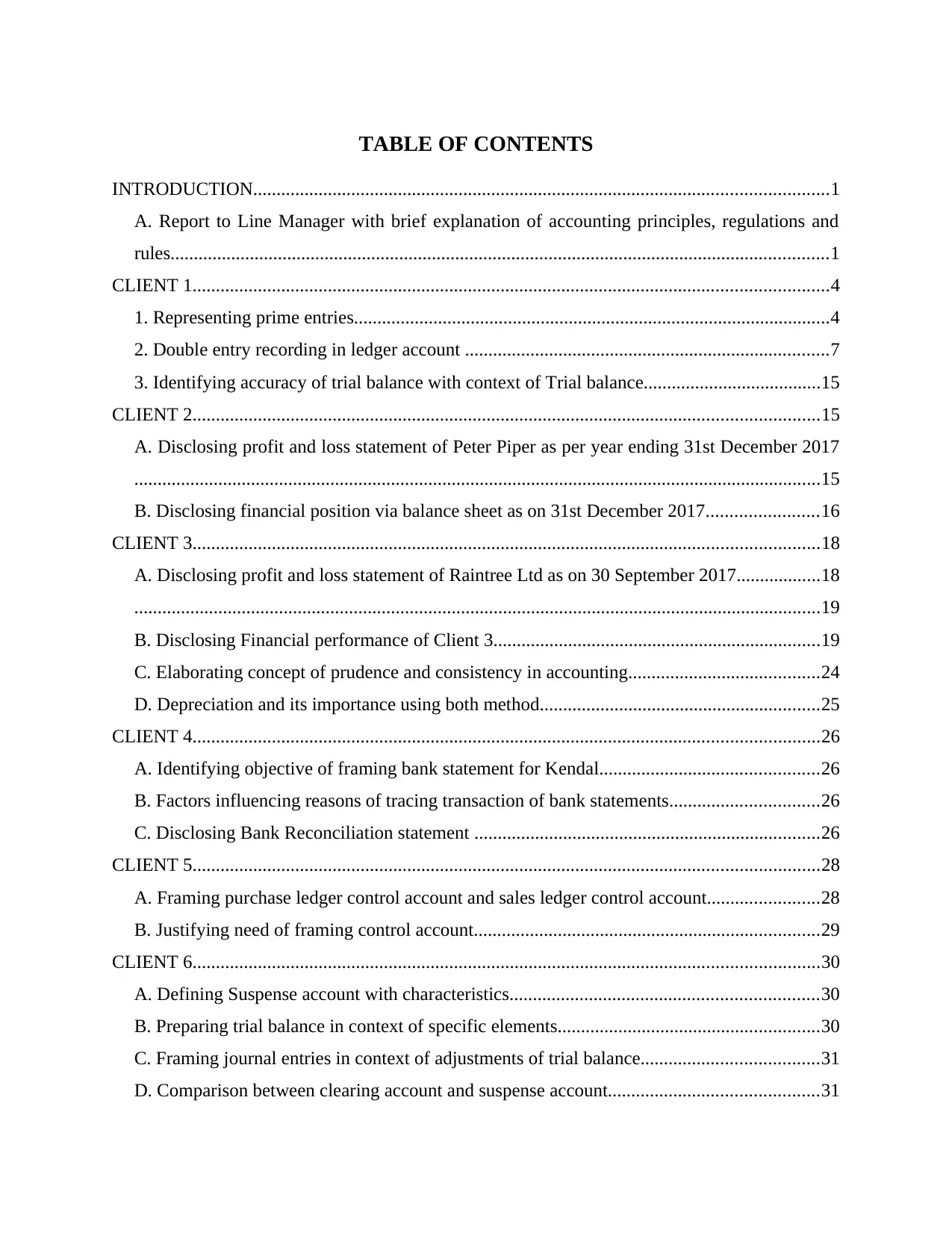
TABLE OF CONTENTS
INTRODUCTION...........................................................................................................................1
A. Report to Line Manager with brief explanation of accounting principles, regulations and
rules.............................................................................................................................................1
CLIENT 1........................................................................................................................................4
1. Representing prime entries......................................................................................................4
2. Double entry recording in ledger account ..............................................................................7
3. Identifying accuracy of trial balance with context of Trial balance......................................15
CLIENT 2......................................................................................................................................15
A. Disclosing profit and loss statement of Peter Piper as per year ending 31st December 2017
...................................................................................................................................................15
B. Disclosing financial position via balance sheet as on 31st December 2017........................16
CLIENT 3......................................................................................................................................18
A. Disclosing profit and loss statement of Raintree Ltd as on 30 September 2017..................18
...................................................................................................................................................19
B. Disclosing Financial performance of Client 3......................................................................19
C. Elaborating concept of prudence and consistency in accounting.........................................24
D. Depreciation and its importance using both method............................................................25
CLIENT 4......................................................................................................................................26
A. Identifying objective of framing bank statement for Kendal...............................................26
B. Factors influencing reasons of tracing transaction of bank statements................................26
C. Disclosing Bank Reconciliation statement ..........................................................................26
CLIENT 5......................................................................................................................................28
A. Framing purchase ledger control account and sales ledger control account........................28
B. Justifying need of framing control account..........................................................................29
CLIENT 6......................................................................................................................................30
A. Defining Suspense account with characteristics..................................................................30
B. Preparing trial balance in context of specific elements........................................................30
C. Framing journal entries in context of adjustments of trial balance......................................31
D. Comparison between clearing account and suspense account.............................................31
INTRODUCTION...........................................................................................................................1
A. Report to Line Manager with brief explanation of accounting principles, regulations and
rules.............................................................................................................................................1
CLIENT 1........................................................................................................................................4
1. Representing prime entries......................................................................................................4
2. Double entry recording in ledger account ..............................................................................7
3. Identifying accuracy of trial balance with context of Trial balance......................................15
CLIENT 2......................................................................................................................................15
A. Disclosing profit and loss statement of Peter Piper as per year ending 31st December 2017
...................................................................................................................................................15
B. Disclosing financial position via balance sheet as on 31st December 2017........................16
CLIENT 3......................................................................................................................................18
A. Disclosing profit and loss statement of Raintree Ltd as on 30 September 2017..................18
...................................................................................................................................................19
B. Disclosing Financial performance of Client 3......................................................................19
C. Elaborating concept of prudence and consistency in accounting.........................................24
D. Depreciation and its importance using both method............................................................25
CLIENT 4......................................................................................................................................26
A. Identifying objective of framing bank statement for Kendal...............................................26
B. Factors influencing reasons of tracing transaction of bank statements................................26
C. Disclosing Bank Reconciliation statement ..........................................................................26
CLIENT 5......................................................................................................................................28
A. Framing purchase ledger control account and sales ledger control account........................28
B. Justifying need of framing control account..........................................................................29
CLIENT 6......................................................................................................................................30
A. Defining Suspense account with characteristics..................................................................30
B. Preparing trial balance in context of specific elements........................................................30
C. Framing journal entries in context of adjustments of trial balance......................................31
D. Comparison between clearing account and suspense account.............................................31
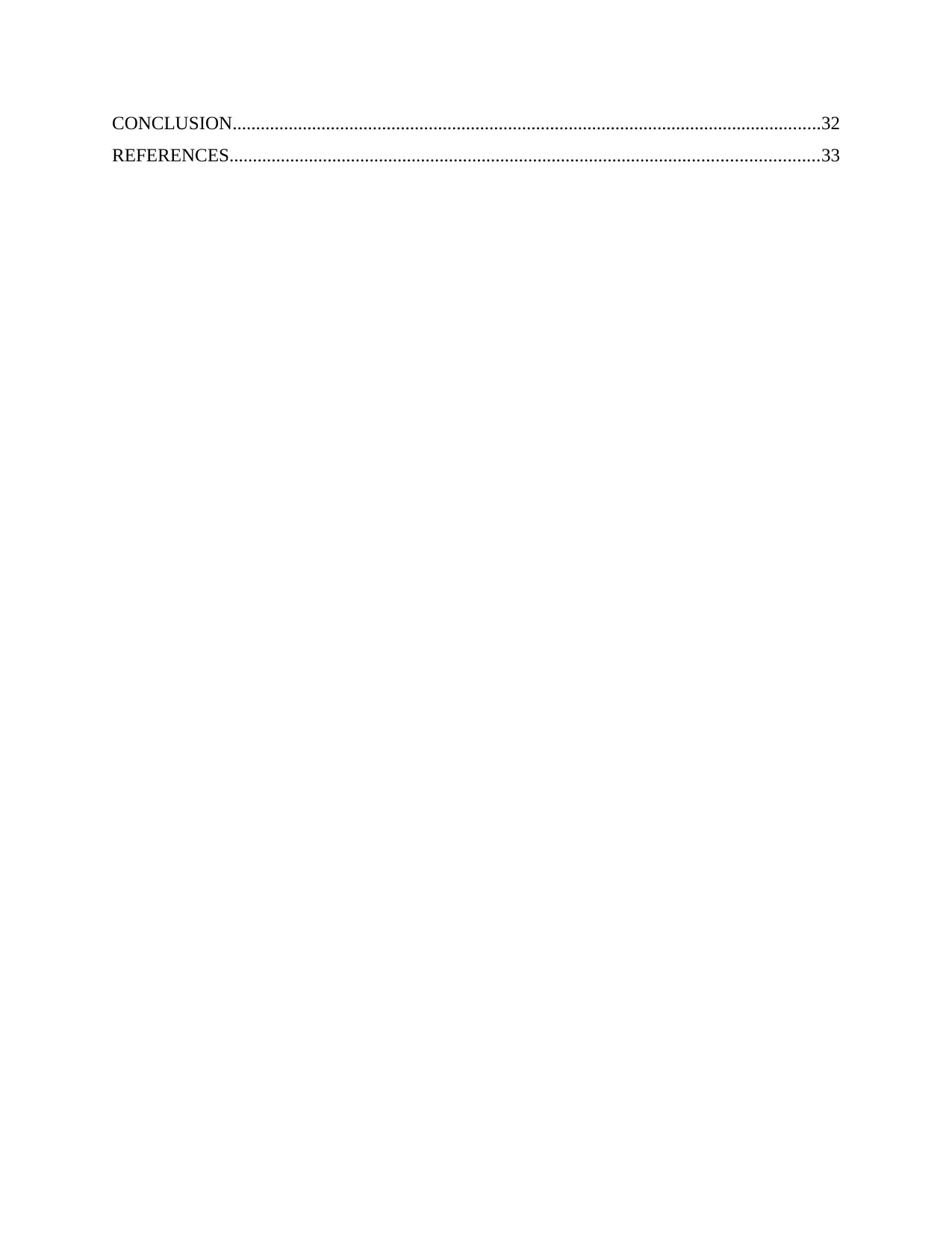
CONCLUSION..............................................................................................................................32
REFERENCES..............................................................................................................................33
REFERENCES..............................................................................................................................33
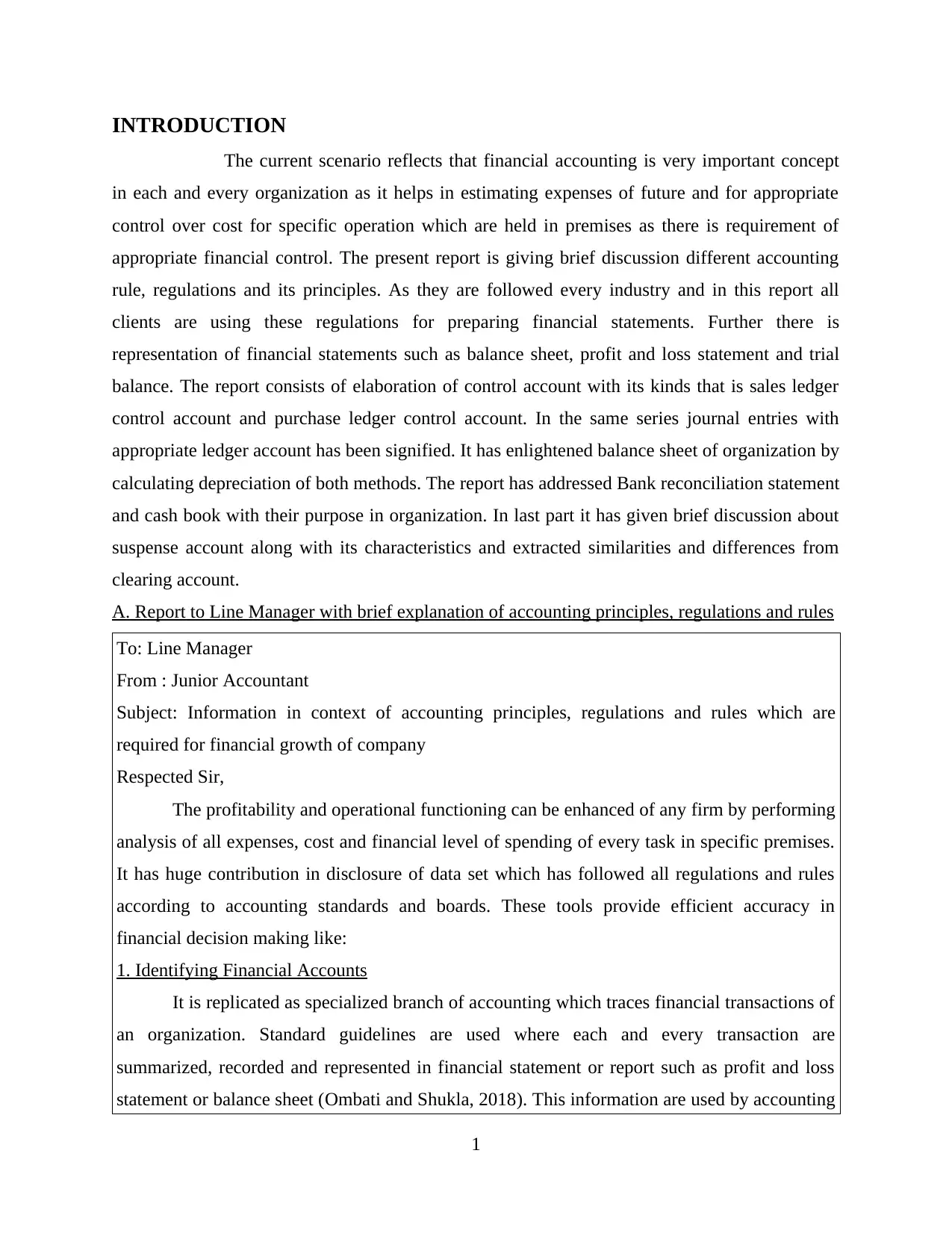
INTRODUCTION
The current scenario reflects that financial accounting is very important concept
in each and every organization as it helps in estimating expenses of future and for appropriate
control over cost for specific operation which are held in premises as there is requirement of
appropriate financial control. The present report is giving brief discussion different accounting
rule, regulations and its principles. As they are followed every industry and in this report all
clients are using these regulations for preparing financial statements. Further there is
representation of financial statements such as balance sheet, profit and loss statement and trial
balance. The report consists of elaboration of control account with its kinds that is sales ledger
control account and purchase ledger control account. In the same series journal entries with
appropriate ledger account has been signified. It has enlightened balance sheet of organization by
calculating depreciation of both methods. The report has addressed Bank reconciliation statement
and cash book with their purpose in organization. In last part it has given brief discussion about
suspense account along with its characteristics and extracted similarities and differences from
clearing account.
A. Report to Line Manager with brief explanation of accounting principles, regulations and rules
To: Line Manager
From : Junior Accountant
Subject: Information in context of accounting principles, regulations and rules which are
required for financial growth of company
Respected Sir,
The profitability and operational functioning can be enhanced of any firm by performing
analysis of all expenses, cost and financial level of spending of every task in specific premises.
It has huge contribution in disclosure of data set which has followed all regulations and rules
according to accounting standards and boards. These tools provide efficient accuracy in
financial decision making like:
1. Identifying Financial Accounts
It is replicated as specialized branch of accounting which traces financial transactions of
an organization. Standard guidelines are used where each and every transaction are
summarized, recorded and represented in financial statement or report such as profit and loss
statement or balance sheet (Ombati and Shukla, 2018). This information are used by accounting
1
The current scenario reflects that financial accounting is very important concept
in each and every organization as it helps in estimating expenses of future and for appropriate
control over cost for specific operation which are held in premises as there is requirement of
appropriate financial control. The present report is giving brief discussion different accounting
rule, regulations and its principles. As they are followed every industry and in this report all
clients are using these regulations for preparing financial statements. Further there is
representation of financial statements such as balance sheet, profit and loss statement and trial
balance. The report consists of elaboration of control account with its kinds that is sales ledger
control account and purchase ledger control account. In the same series journal entries with
appropriate ledger account has been signified. It has enlightened balance sheet of organization by
calculating depreciation of both methods. The report has addressed Bank reconciliation statement
and cash book with their purpose in organization. In last part it has given brief discussion about
suspense account along with its characteristics and extracted similarities and differences from
clearing account.
A. Report to Line Manager with brief explanation of accounting principles, regulations and rules
To: Line Manager
From : Junior Accountant
Subject: Information in context of accounting principles, regulations and rules which are
required for financial growth of company
Respected Sir,
The profitability and operational functioning can be enhanced of any firm by performing
analysis of all expenses, cost and financial level of spending of every task in specific premises.
It has huge contribution in disclosure of data set which has followed all regulations and rules
according to accounting standards and boards. These tools provide efficient accuracy in
financial decision making like:
1. Identifying Financial Accounts
It is replicated as specialized branch of accounting which traces financial transactions of
an organization. Standard guidelines are used where each and every transaction are
summarized, recorded and represented in financial statement or report such as profit and loss
statement or balance sheet (Ombati and Shukla, 2018). This information are used by accounting
1
Secure Best Marks with AI Grader
Need help grading? Try our AI Grader for instant feedback on your assignments.
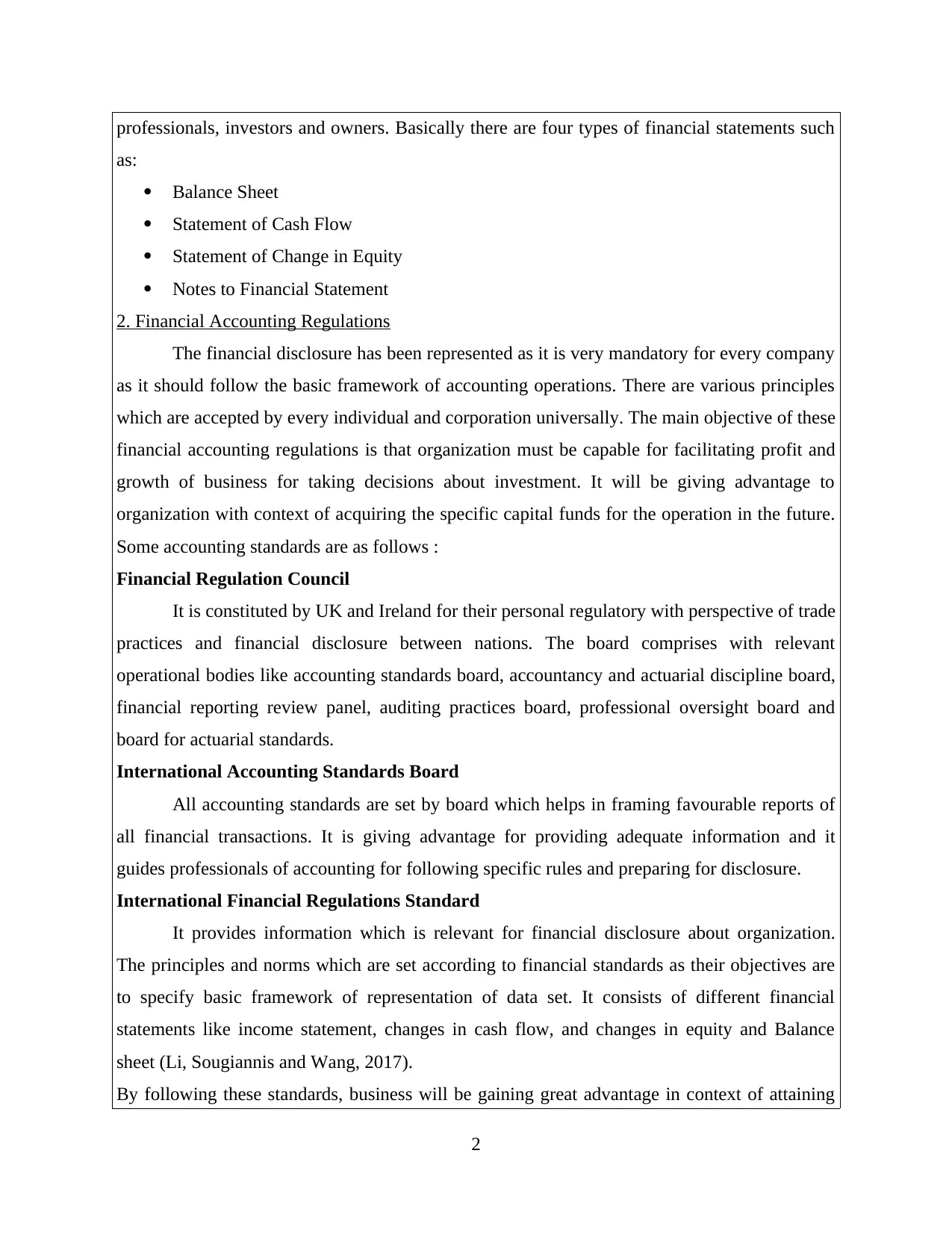
professionals, investors and owners. Basically there are four types of financial statements such
as:
Balance Sheet
Statement of Cash Flow
Statement of Change in Equity
Notes to Financial Statement
2. Financial Accounting Regulations
The financial disclosure has been represented as it is very mandatory for every company
as it should follow the basic framework of accounting operations. There are various principles
which are accepted by every individual and corporation universally. The main objective of these
financial accounting regulations is that organization must be capable for facilitating profit and
growth of business for taking decisions about investment. It will be giving advantage to
organization with context of acquiring the specific capital funds for the operation in the future.
Some accounting standards are as follows :
Financial Regulation Council
It is constituted by UK and Ireland for their personal regulatory with perspective of trade
practices and financial disclosure between nations. The board comprises with relevant
operational bodies like accounting standards board, accountancy and actuarial discipline board,
financial reporting review panel, auditing practices board, professional oversight board and
board for actuarial standards.
International Accounting Standards Board
All accounting standards are set by board which helps in framing favourable reports of
all financial transactions. It is giving advantage for providing adequate information and it
guides professionals of accounting for following specific rules and preparing for disclosure.
International Financial Regulations Standard
It provides information which is relevant for financial disclosure about organization.
The principles and norms which are set according to financial standards as their objectives are
to specify basic framework of representation of data set. It consists of different financial
statements like income statement, changes in cash flow, and changes in equity and Balance
sheet (Li, Sougiannis and Wang, 2017).
By following these standards, business will be gaining great advantage in context of attaining
2
as:
Balance Sheet
Statement of Cash Flow
Statement of Change in Equity
Notes to Financial Statement
2. Financial Accounting Regulations
The financial disclosure has been represented as it is very mandatory for every company
as it should follow the basic framework of accounting operations. There are various principles
which are accepted by every individual and corporation universally. The main objective of these
financial accounting regulations is that organization must be capable for facilitating profit and
growth of business for taking decisions about investment. It will be giving advantage to
organization with context of acquiring the specific capital funds for the operation in the future.
Some accounting standards are as follows :
Financial Regulation Council
It is constituted by UK and Ireland for their personal regulatory with perspective of trade
practices and financial disclosure between nations. The board comprises with relevant
operational bodies like accounting standards board, accountancy and actuarial discipline board,
financial reporting review panel, auditing practices board, professional oversight board and
board for actuarial standards.
International Accounting Standards Board
All accounting standards are set by board which helps in framing favourable reports of
all financial transactions. It is giving advantage for providing adequate information and it
guides professionals of accounting for following specific rules and preparing for disclosure.
International Financial Regulations Standard
It provides information which is relevant for financial disclosure about organization.
The principles and norms which are set according to financial standards as their objectives are
to specify basic framework of representation of data set. It consists of different financial
statements like income statement, changes in cash flow, and changes in equity and Balance
sheet (Li, Sougiannis and Wang, 2017).
By following these standards, business will be gaining great advantage in context of attaining
2
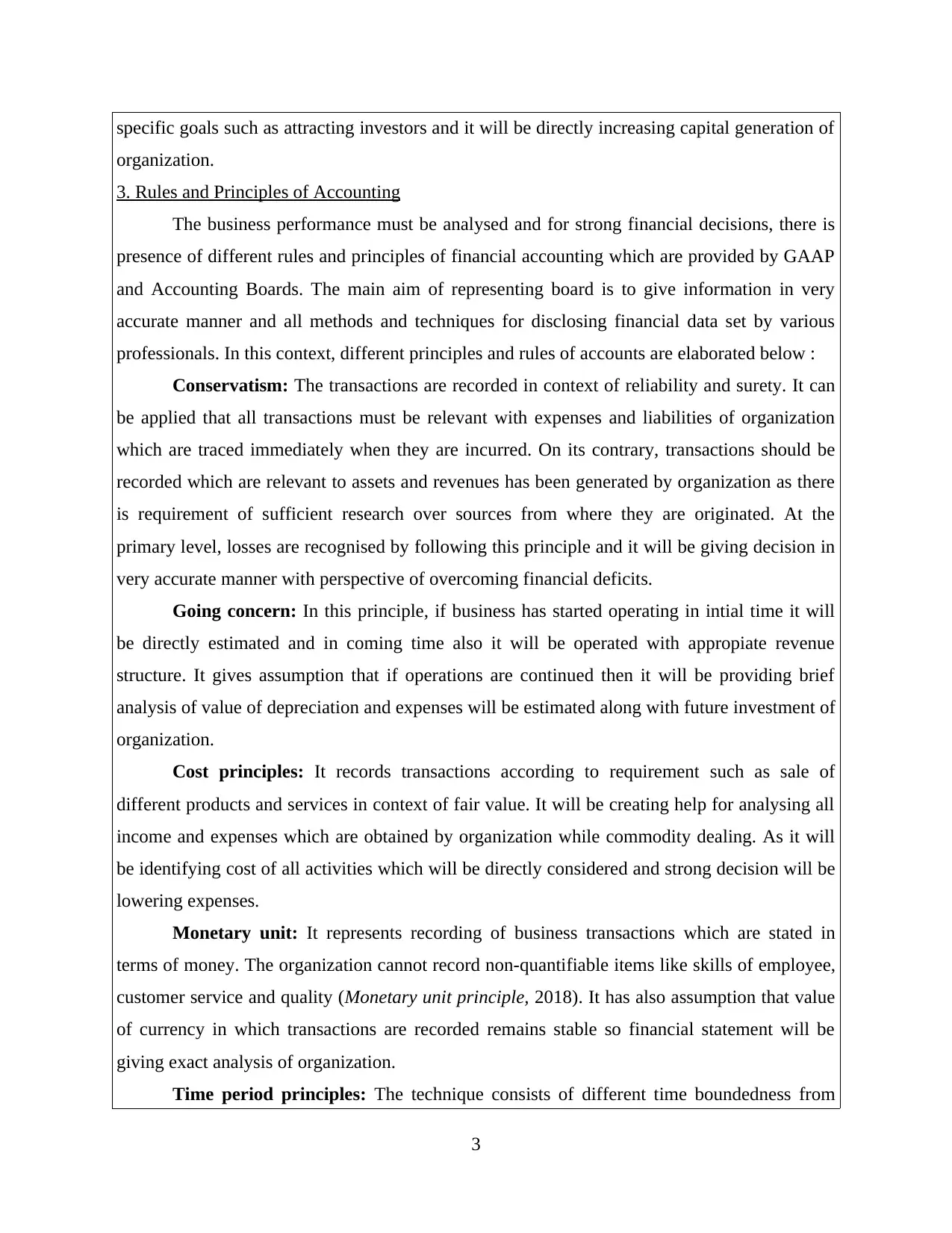
specific goals such as attracting investors and it will be directly increasing capital generation of
organization.
3. Rules and Principles of Accounting
The business performance must be analysed and for strong financial decisions, there is
presence of different rules and principles of financial accounting which are provided by GAAP
and Accounting Boards. The main aim of representing board is to give information in very
accurate manner and all methods and techniques for disclosing financial data set by various
professionals. In this context, different principles and rules of accounts are elaborated below :
Conservatism: The transactions are recorded in context of reliability and surety. It can
be applied that all transactions must be relevant with expenses and liabilities of organization
which are traced immediately when they are incurred. On its contrary, transactions should be
recorded which are relevant to assets and revenues has been generated by organization as there
is requirement of sufficient research over sources from where they are originated. At the
primary level, losses are recognised by following this principle and it will be giving decision in
very accurate manner with perspective of overcoming financial deficits.
Going concern: In this principle, if business has started operating in intial time it will
be directly estimated and in coming time also it will be operated with appropiate revenue
structure. It gives assumption that if operations are continued then it will be providing brief
analysis of value of depreciation and expenses will be estimated along with future investment of
organization.
Cost principles: It records transactions according to requirement such as sale of
different products and services in context of fair value. It will be creating help for analysing all
income and expenses which are obtained by organization while commodity dealing. As it will
be identifying cost of all activities which will be directly considered and strong decision will be
lowering expenses.
Monetary unit: It represents recording of business transactions which are stated in
terms of money. The organization cannot record non-quantifiable items like skills of employee,
customer service and quality (Monetary unit principle, 2018). It has also assumption that value
of currency in which transactions are recorded remains stable so financial statement will be
giving exact analysis of organization.
Time period principles: The technique consists of different time boundedness from
3
organization.
3. Rules and Principles of Accounting
The business performance must be analysed and for strong financial decisions, there is
presence of different rules and principles of financial accounting which are provided by GAAP
and Accounting Boards. The main aim of representing board is to give information in very
accurate manner and all methods and techniques for disclosing financial data set by various
professionals. In this context, different principles and rules of accounts are elaborated below :
Conservatism: The transactions are recorded in context of reliability and surety. It can
be applied that all transactions must be relevant with expenses and liabilities of organization
which are traced immediately when they are incurred. On its contrary, transactions should be
recorded which are relevant to assets and revenues has been generated by organization as there
is requirement of sufficient research over sources from where they are originated. At the
primary level, losses are recognised by following this principle and it will be giving decision in
very accurate manner with perspective of overcoming financial deficits.
Going concern: In this principle, if business has started operating in intial time it will
be directly estimated and in coming time also it will be operated with appropiate revenue
structure. It gives assumption that if operations are continued then it will be providing brief
analysis of value of depreciation and expenses will be estimated along with future investment of
organization.
Cost principles: It records transactions according to requirement such as sale of
different products and services in context of fair value. It will be creating help for analysing all
income and expenses which are obtained by organization while commodity dealing. As it will
be identifying cost of all activities which will be directly considered and strong decision will be
lowering expenses.
Monetary unit: It represents recording of business transactions which are stated in
terms of money. The organization cannot record non-quantifiable items like skills of employee,
customer service and quality (Monetary unit principle, 2018). It has also assumption that value
of currency in which transactions are recorded remains stable so financial statement will be
giving exact analysis of organization.
Time period principles: The technique consists of different time boundedness from
3
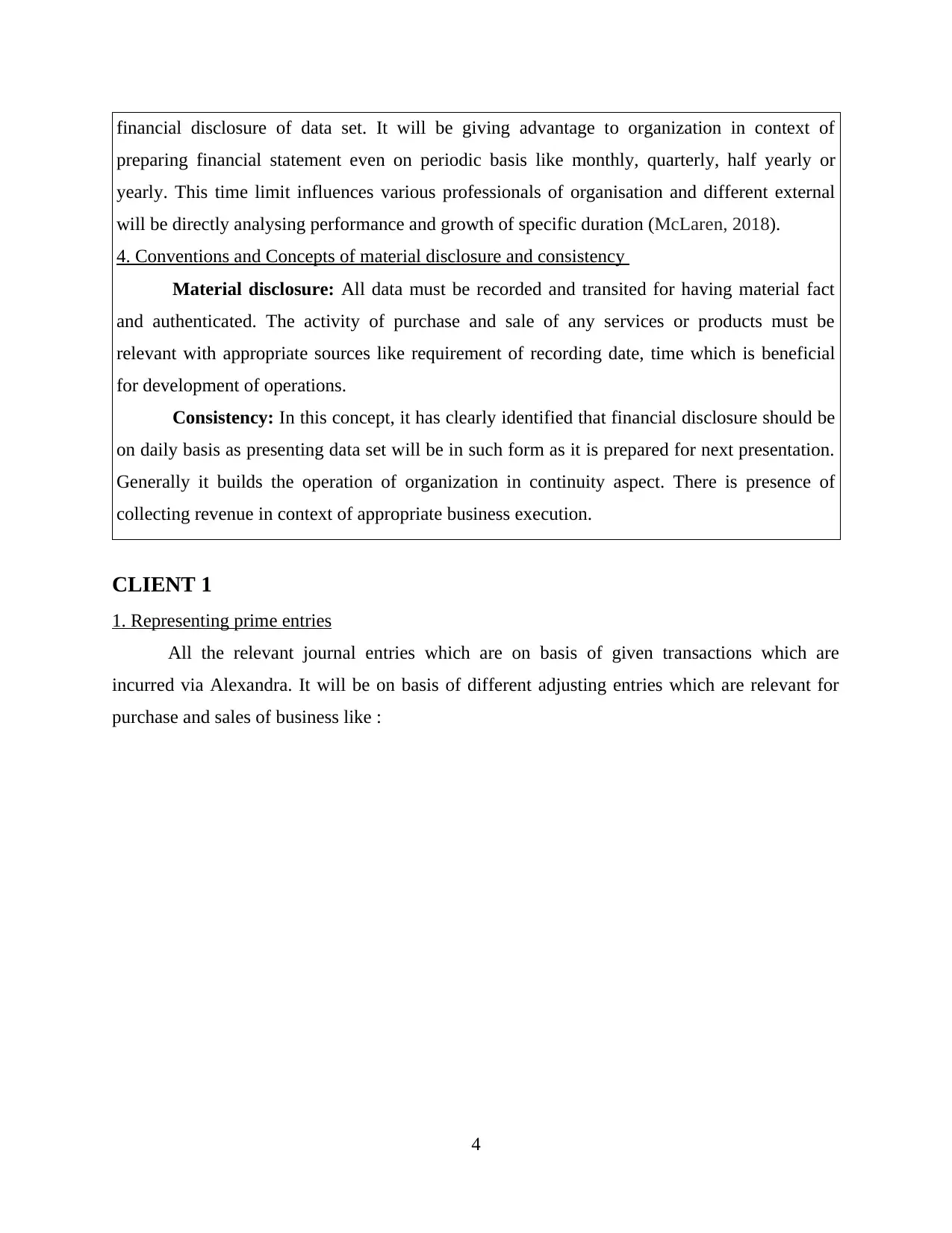
financial disclosure of data set. It will be giving advantage to organization in context of
preparing financial statement even on periodic basis like monthly, quarterly, half yearly or
yearly. This time limit influences various professionals of organisation and different external
will be directly analysing performance and growth of specific duration (McLaren, 2018).
4. Conventions and Concepts of material disclosure and consistency
Material disclosure: All data must be recorded and transited for having material fact
and authenticated. The activity of purchase and sale of any services or products must be
relevant with appropriate sources like requirement of recording date, time which is beneficial
for development of operations.
Consistency: In this concept, it has clearly identified that financial disclosure should be
on daily basis as presenting data set will be in such form as it is prepared for next presentation.
Generally it builds the operation of organization in continuity aspect. There is presence of
collecting revenue in context of appropriate business execution.
CLIENT 1
1. Representing prime entries
All the relevant journal entries which are on basis of given transactions which are
incurred via Alexandra. It will be on basis of different adjusting entries which are relevant for
purchase and sales of business like :
4
preparing financial statement even on periodic basis like monthly, quarterly, half yearly or
yearly. This time limit influences various professionals of organisation and different external
will be directly analysing performance and growth of specific duration (McLaren, 2018).
4. Conventions and Concepts of material disclosure and consistency
Material disclosure: All data must be recorded and transited for having material fact
and authenticated. The activity of purchase and sale of any services or products must be
relevant with appropriate sources like requirement of recording date, time which is beneficial
for development of operations.
Consistency: In this concept, it has clearly identified that financial disclosure should be
on daily basis as presenting data set will be in such form as it is prepared for next presentation.
Generally it builds the operation of organization in continuity aspect. There is presence of
collecting revenue in context of appropriate business execution.
CLIENT 1
1. Representing prime entries
All the relevant journal entries which are on basis of given transactions which are
incurred via Alexandra. It will be on basis of different adjusting entries which are relevant for
purchase and sales of business like :
4
Paraphrase This Document
Need a fresh take? Get an instant paraphrase of this document with our AI Paraphraser
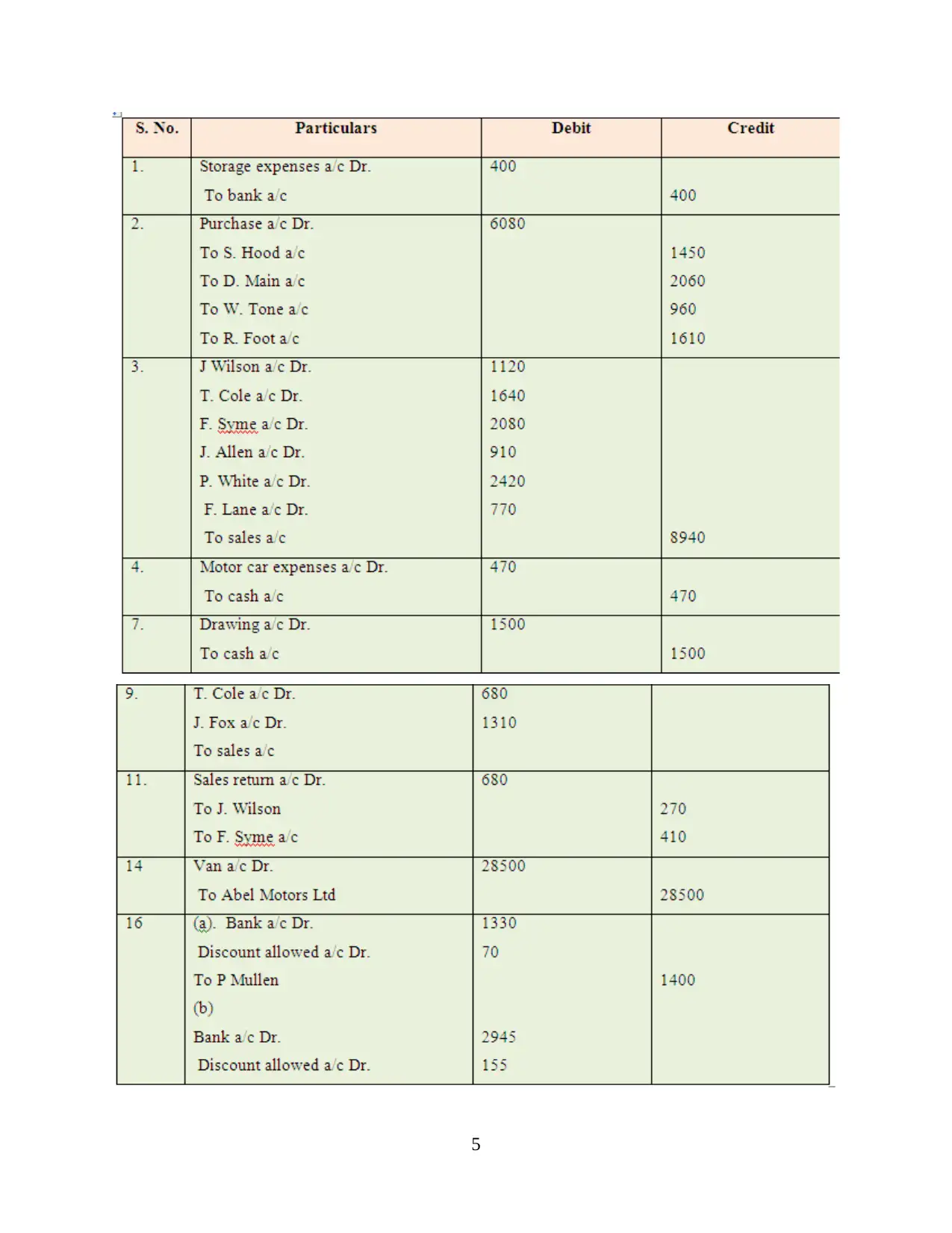
5
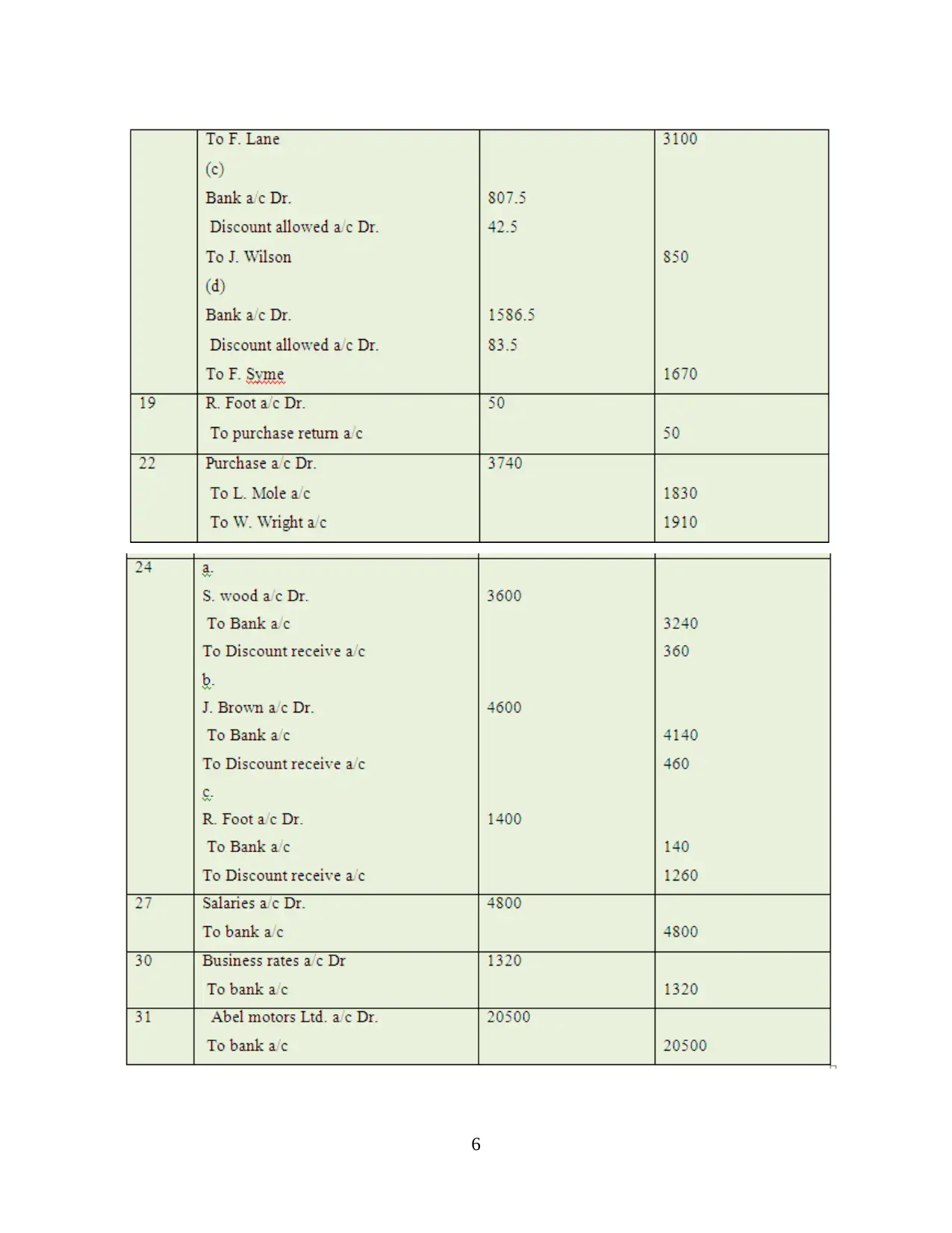
6

2. Double entry recording in ledger account
According to above journal entries, there is representation of all transactions and account
holders in specific ledger account below:
7
According to above journal entries, there is representation of all transactions and account
holders in specific ledger account below:
7
Secure Best Marks with AI Grader
Need help grading? Try our AI Grader for instant feedback on your assignments.
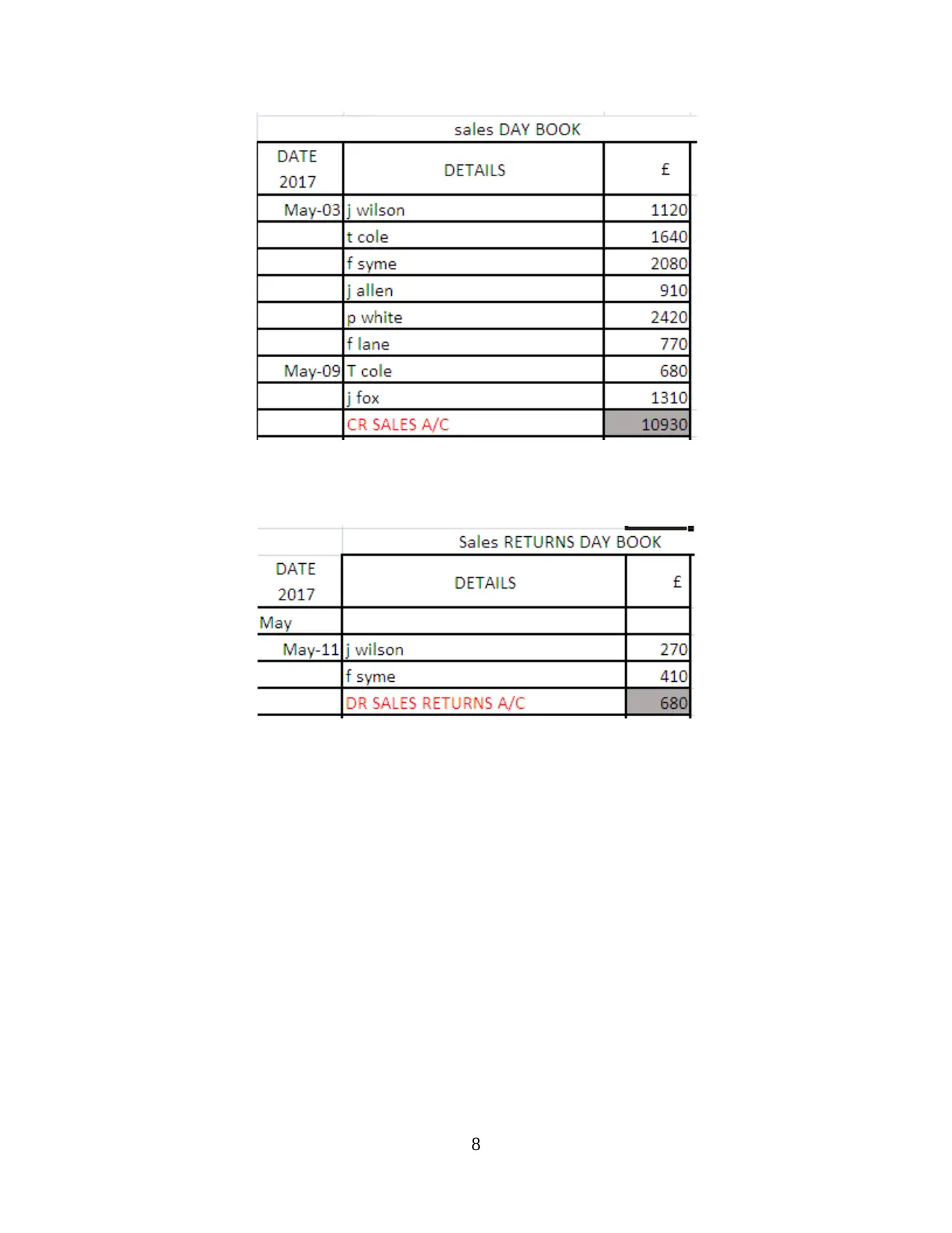
8

9
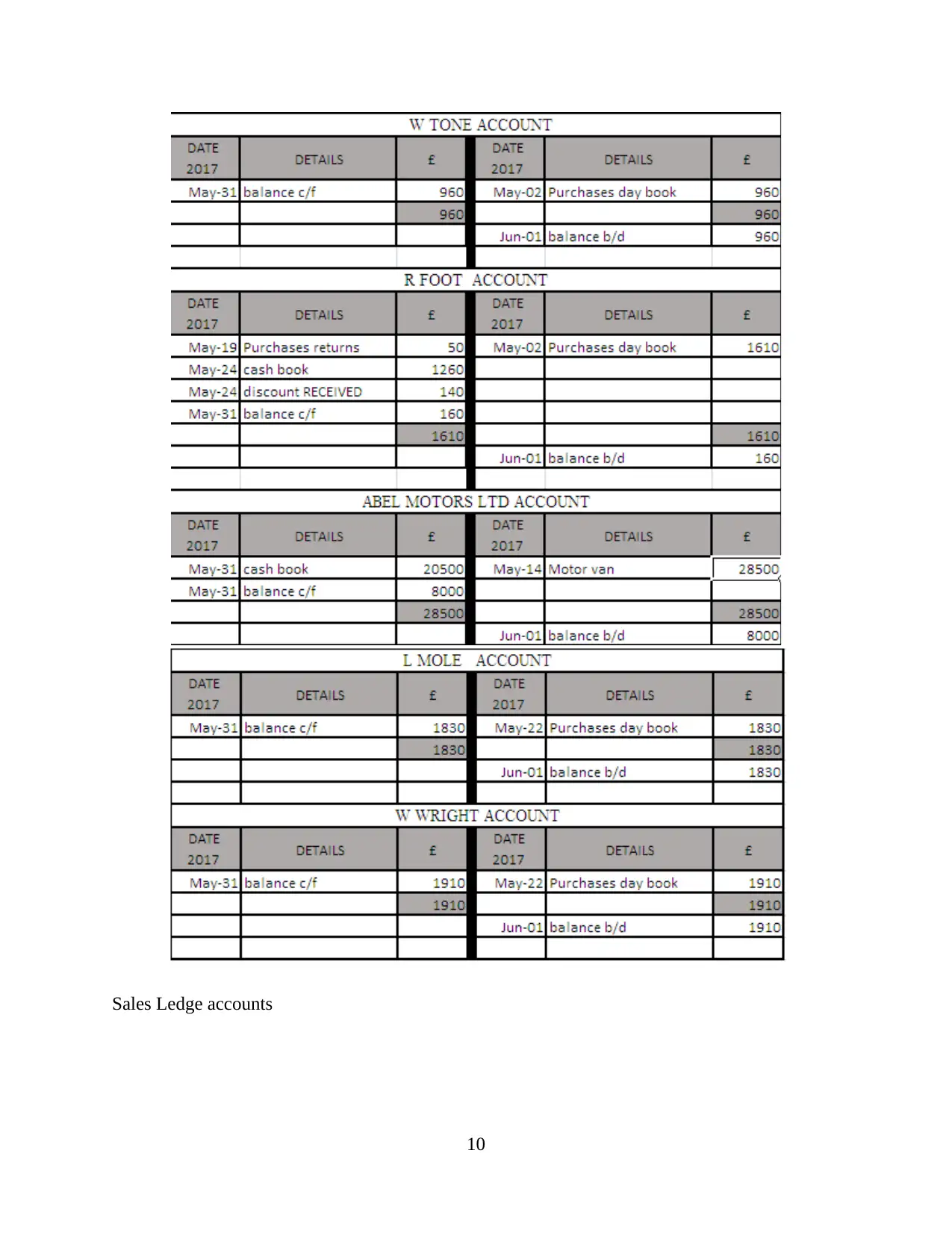
Sales Ledge accounts
10
10
Paraphrase This Document
Need a fresh take? Get an instant paraphrase of this document with our AI Paraphraser
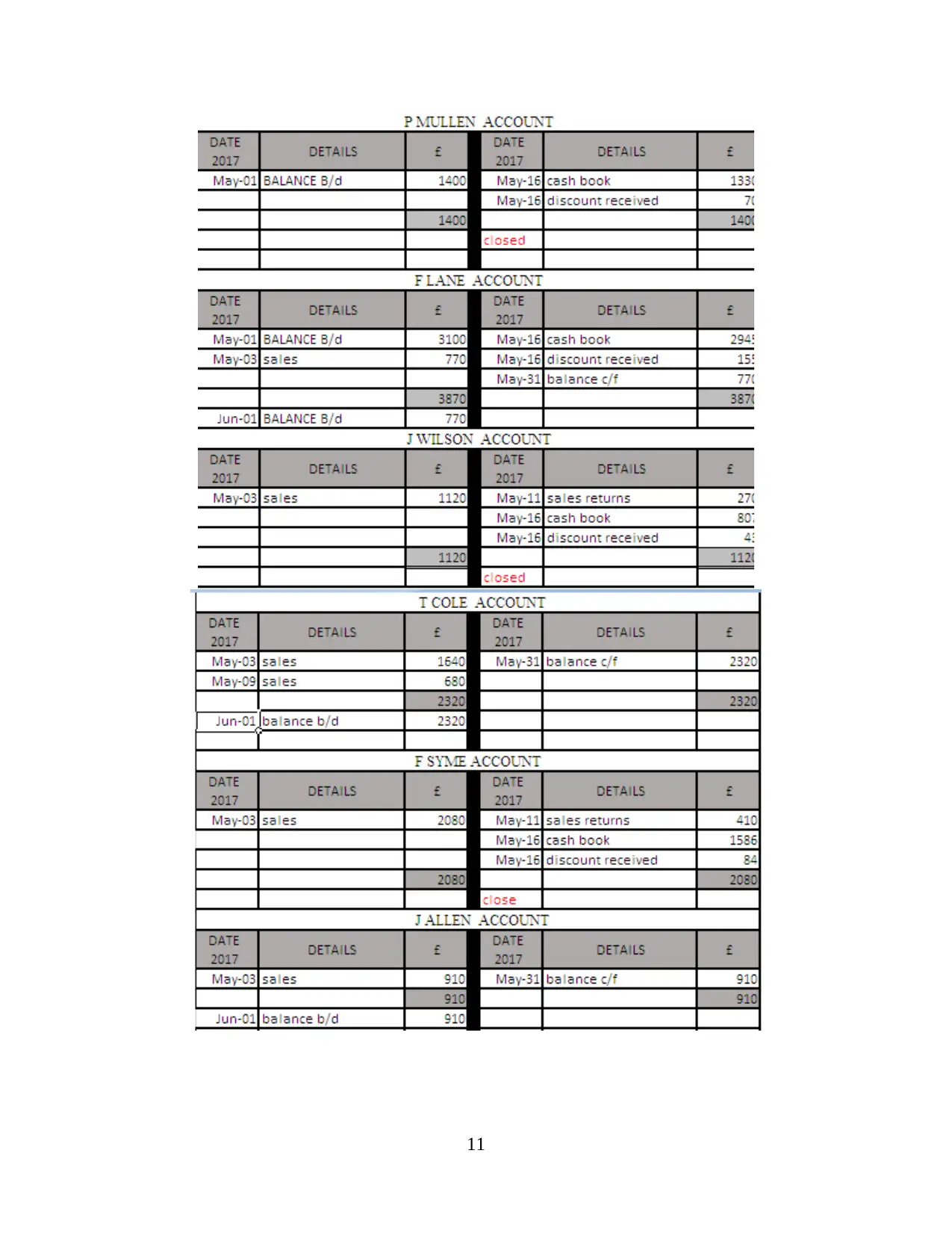
11
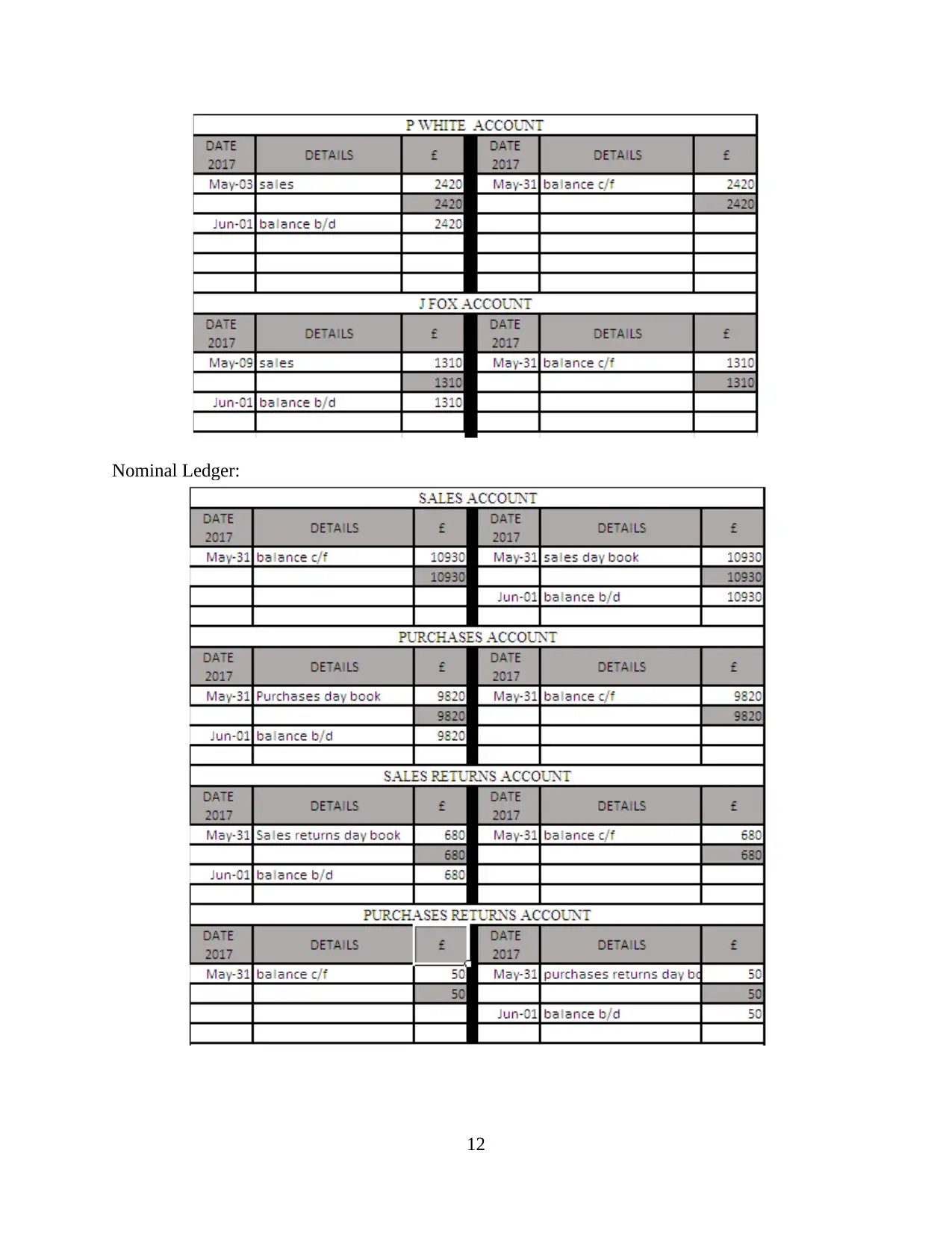
Nominal Ledger:
12
12
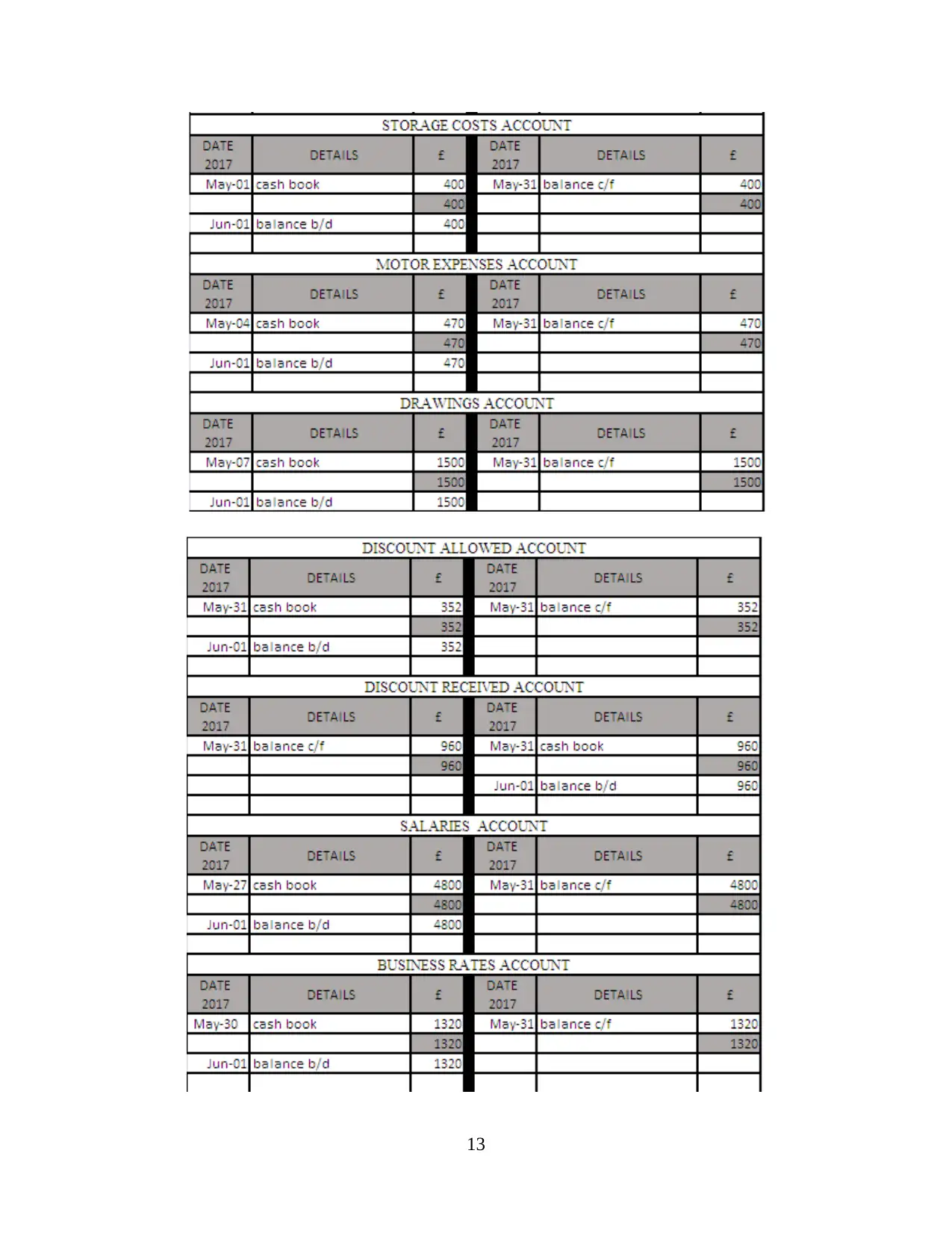
13
Secure Best Marks with AI Grader
Need help grading? Try our AI Grader for instant feedback on your assignments.
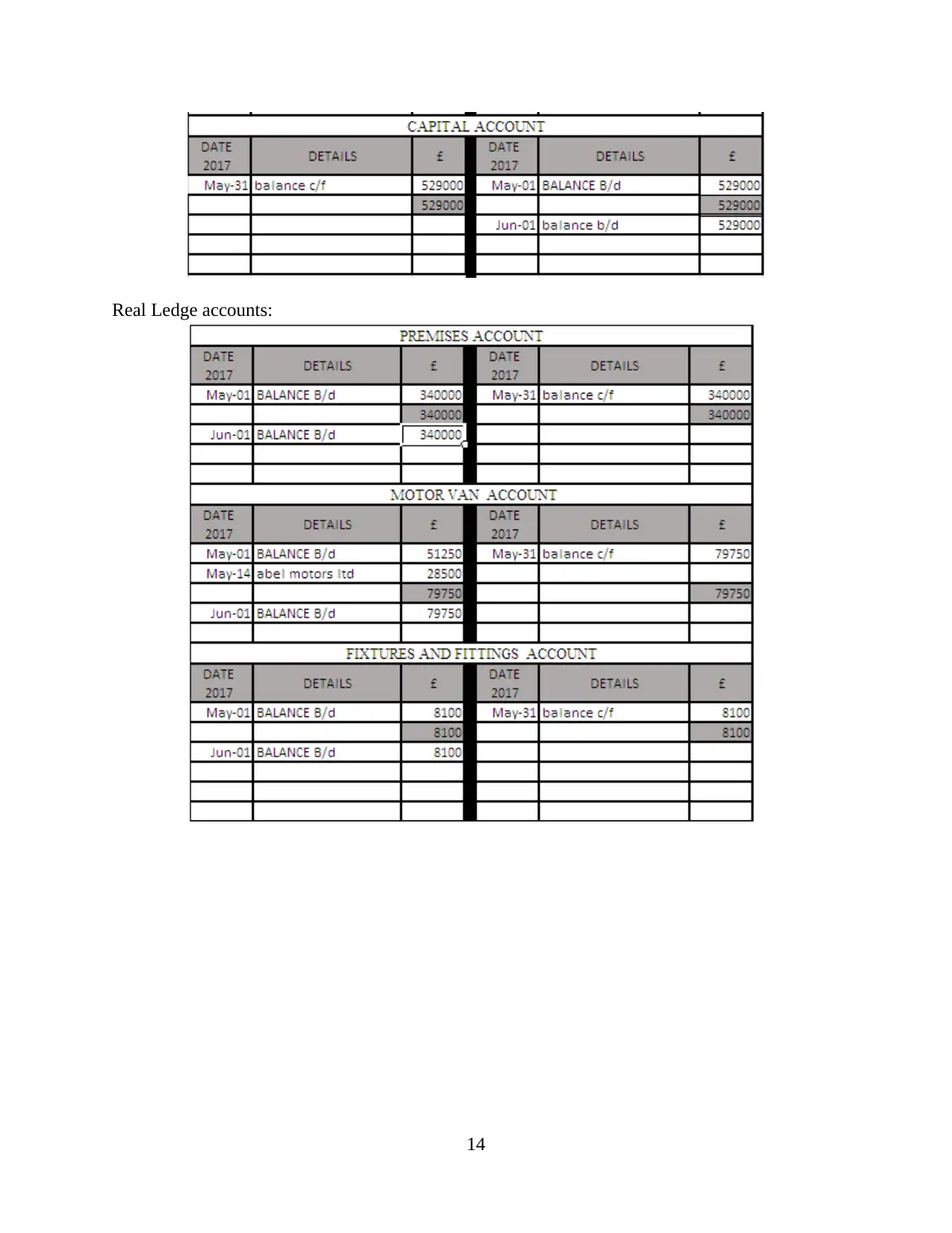
Real Ledge accounts:
14
14
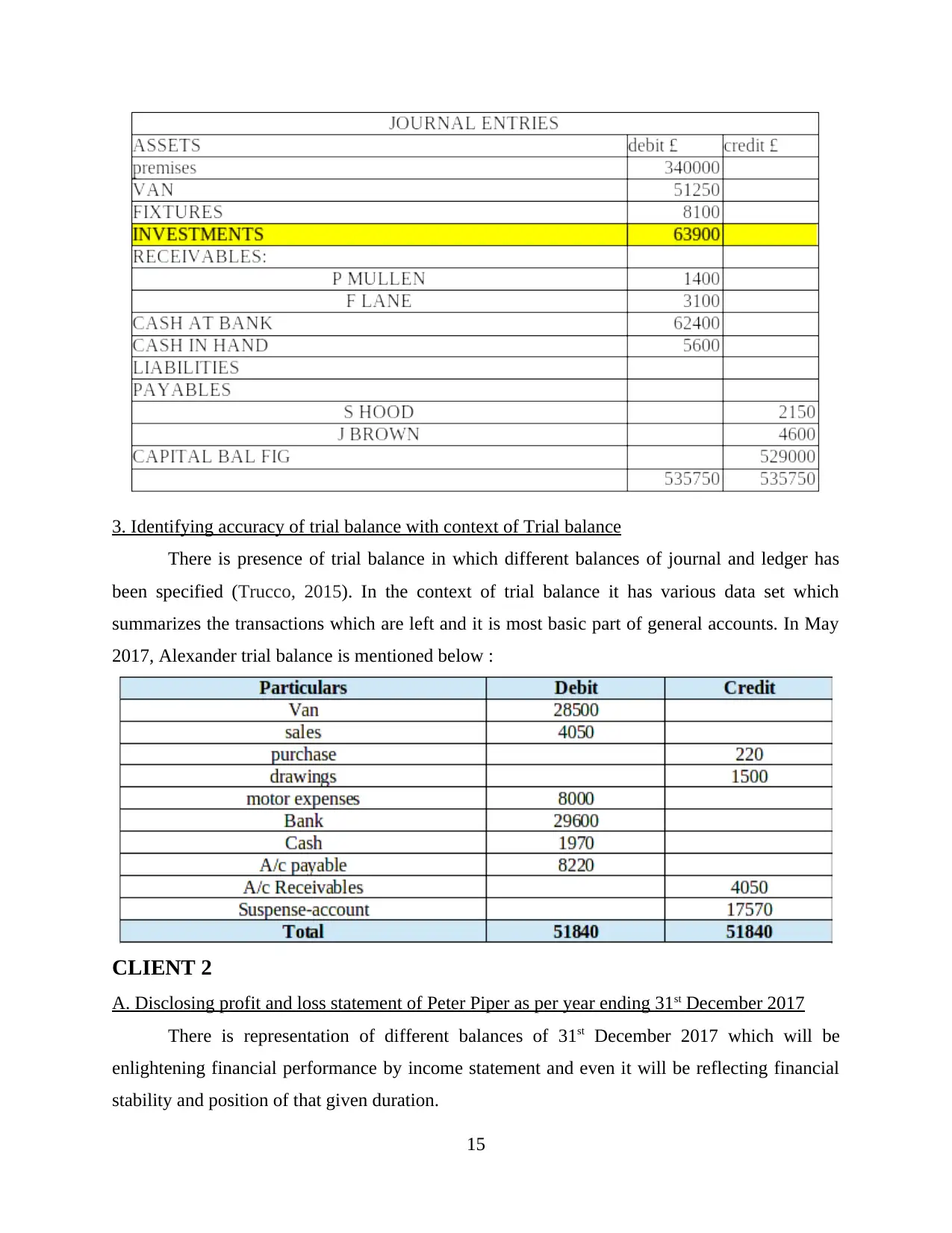
3. Identifying accuracy of trial balance with context of Trial balance
There is presence of trial balance in which different balances of journal and ledger has
been specified (Trucco, 2015). In the context of trial balance it has various data set which
summarizes the transactions which are left and it is most basic part of general accounts. In May
2017, Alexander trial balance is mentioned below :
CLIENT 2
A. Disclosing profit and loss statement of Peter Piper as per year ending 31st December 2017
There is representation of different balances of 31st December 2017 which will be
enlightening financial performance by income statement and even it will be reflecting financial
stability and position of that given duration.
15
There is presence of trial balance in which different balances of journal and ledger has
been specified (Trucco, 2015). In the context of trial balance it has various data set which
summarizes the transactions which are left and it is most basic part of general accounts. In May
2017, Alexander trial balance is mentioned below :
CLIENT 2
A. Disclosing profit and loss statement of Peter Piper as per year ending 31st December 2017
There is representation of different balances of 31st December 2017 which will be
enlightening financial performance by income statement and even it will be reflecting financial
stability and position of that given duration.
15
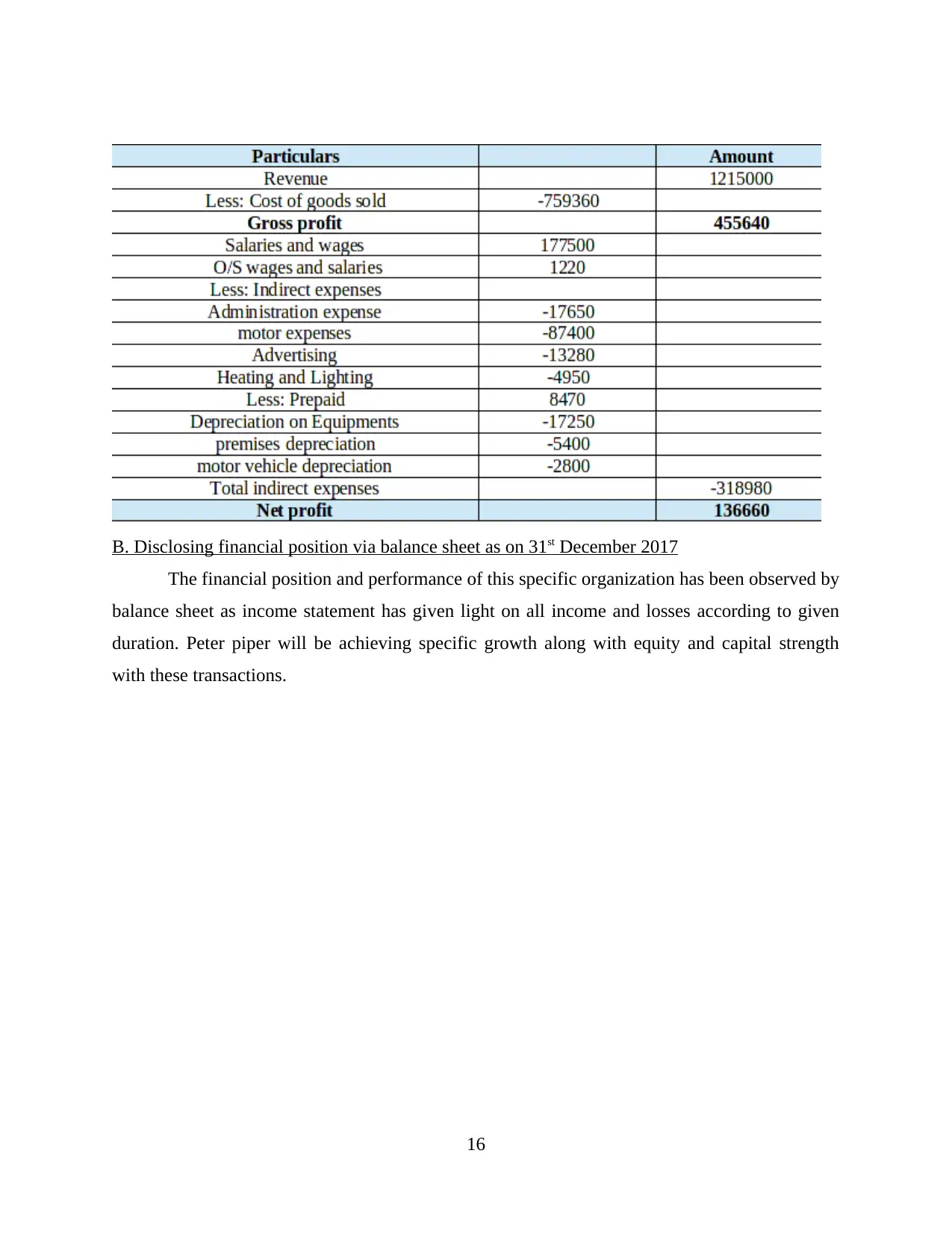
B. Disclosing financial position via balance sheet as on 31st December 2017
The financial position and performance of this specific organization has been observed by
balance sheet as income statement has given light on all income and losses according to given
duration. Peter piper will be achieving specific growth along with equity and capital strength
with these transactions.
16
The financial position and performance of this specific organization has been observed by
balance sheet as income statement has given light on all income and losses according to given
duration. Peter piper will be achieving specific growth along with equity and capital strength
with these transactions.
16
Paraphrase This Document
Need a fresh take? Get an instant paraphrase of this document with our AI Paraphraser
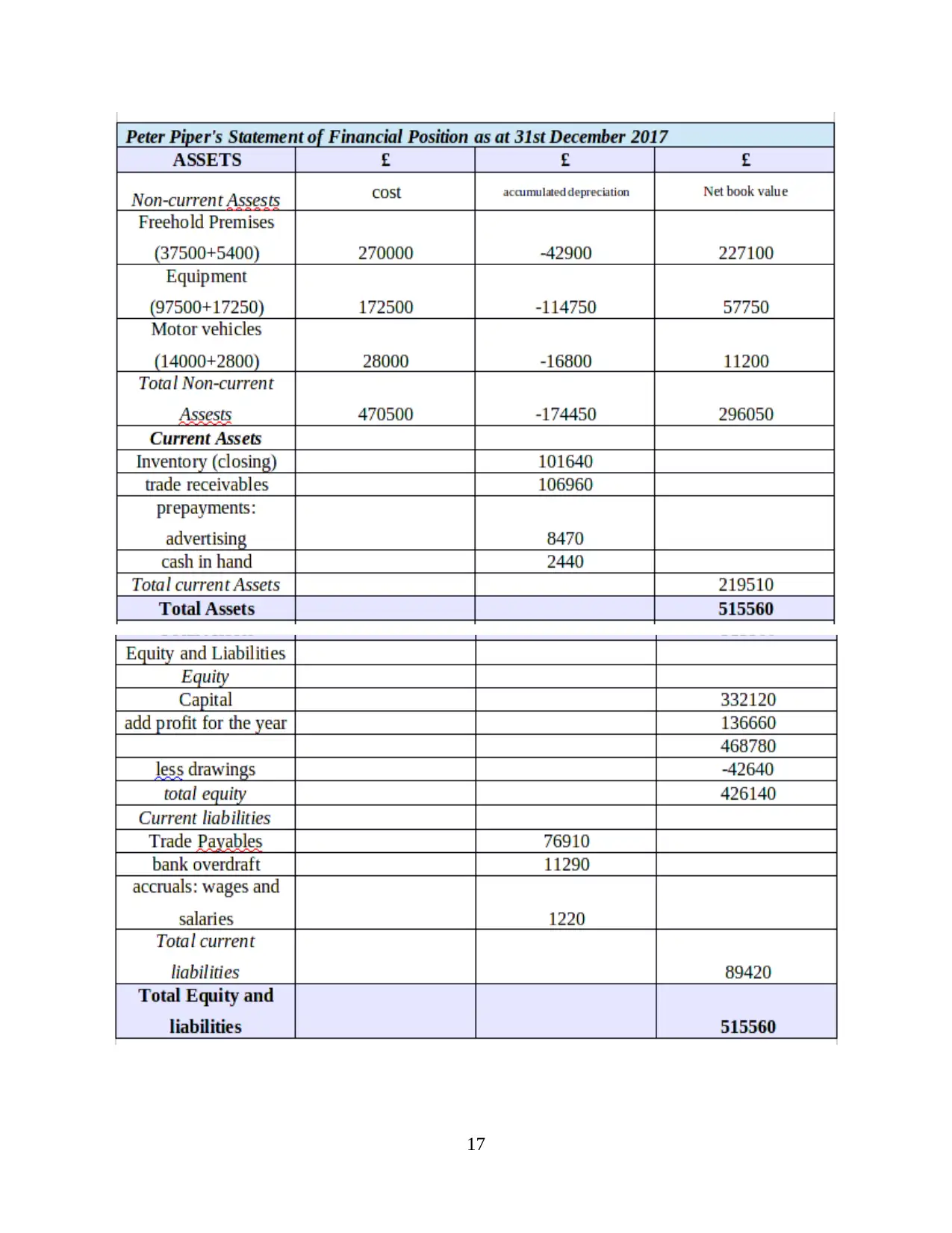
17
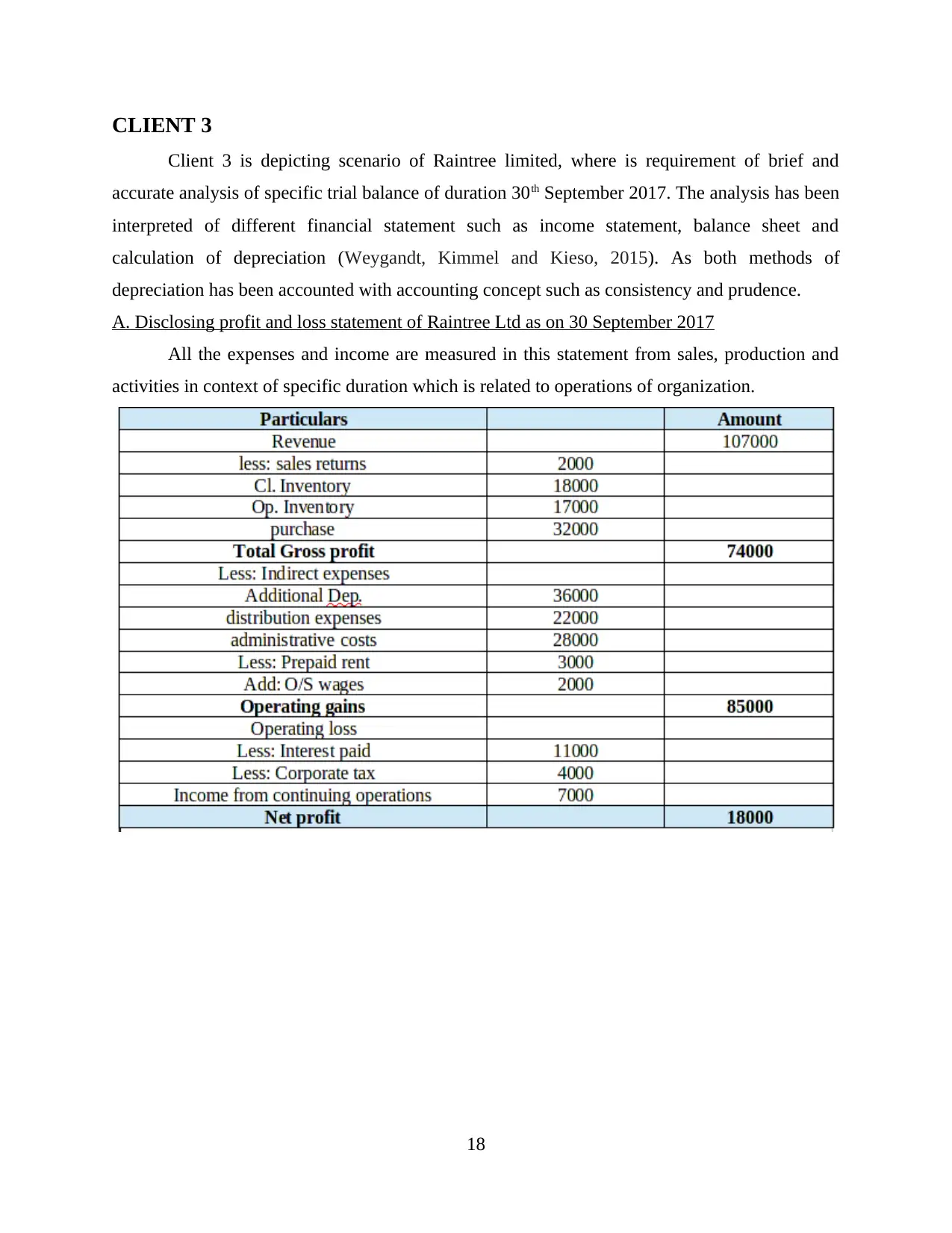
CLIENT 3
Client 3 is depicting scenario of Raintree limited, where is requirement of brief and
accurate analysis of specific trial balance of duration 30th September 2017. The analysis has been
interpreted of different financial statement such as income statement, balance sheet and
calculation of depreciation (Weygandt, Kimmel and Kieso, 2015). As both methods of
depreciation has been accounted with accounting concept such as consistency and prudence.
A. Disclosing profit and loss statement of Raintree Ltd as on 30 September 2017
All the expenses and income are measured in this statement from sales, production and
activities in context of specific duration which is related to operations of organization.
18
Client 3 is depicting scenario of Raintree limited, where is requirement of brief and
accurate analysis of specific trial balance of duration 30th September 2017. The analysis has been
interpreted of different financial statement such as income statement, balance sheet and
calculation of depreciation (Weygandt, Kimmel and Kieso, 2015). As both methods of
depreciation has been accounted with accounting concept such as consistency and prudence.
A. Disclosing profit and loss statement of Raintree Ltd as on 30 September 2017
All the expenses and income are measured in this statement from sales, production and
activities in context of specific duration which is related to operations of organization.
18
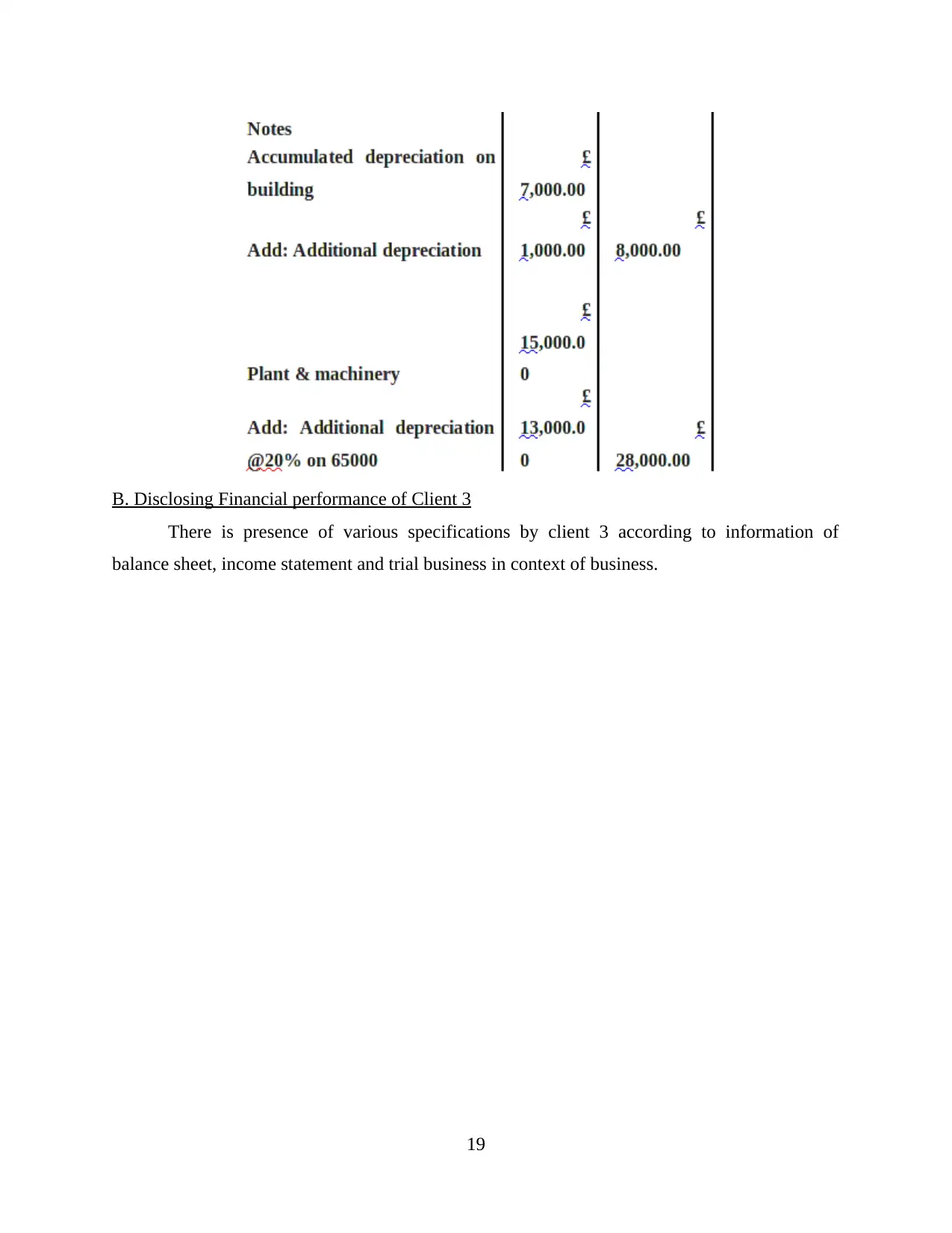
B. Disclosing Financial performance of Client 3
There is presence of various specifications by client 3 according to information of
balance sheet, income statement and trial business in context of business.
19
There is presence of various specifications by client 3 according to information of
balance sheet, income statement and trial business in context of business.
19
Secure Best Marks with AI Grader
Need help grading? Try our AI Grader for instant feedback on your assignments.
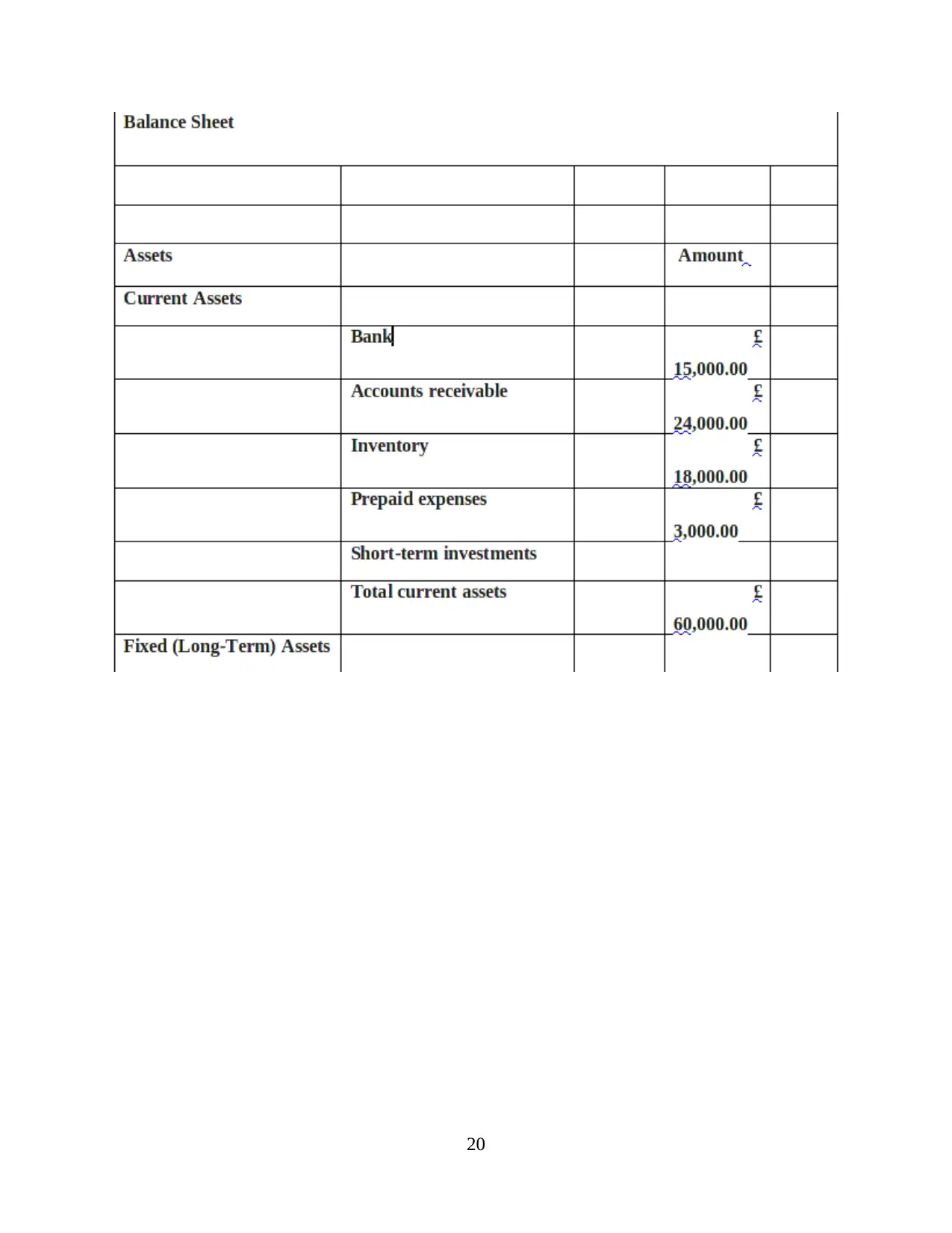
20

21
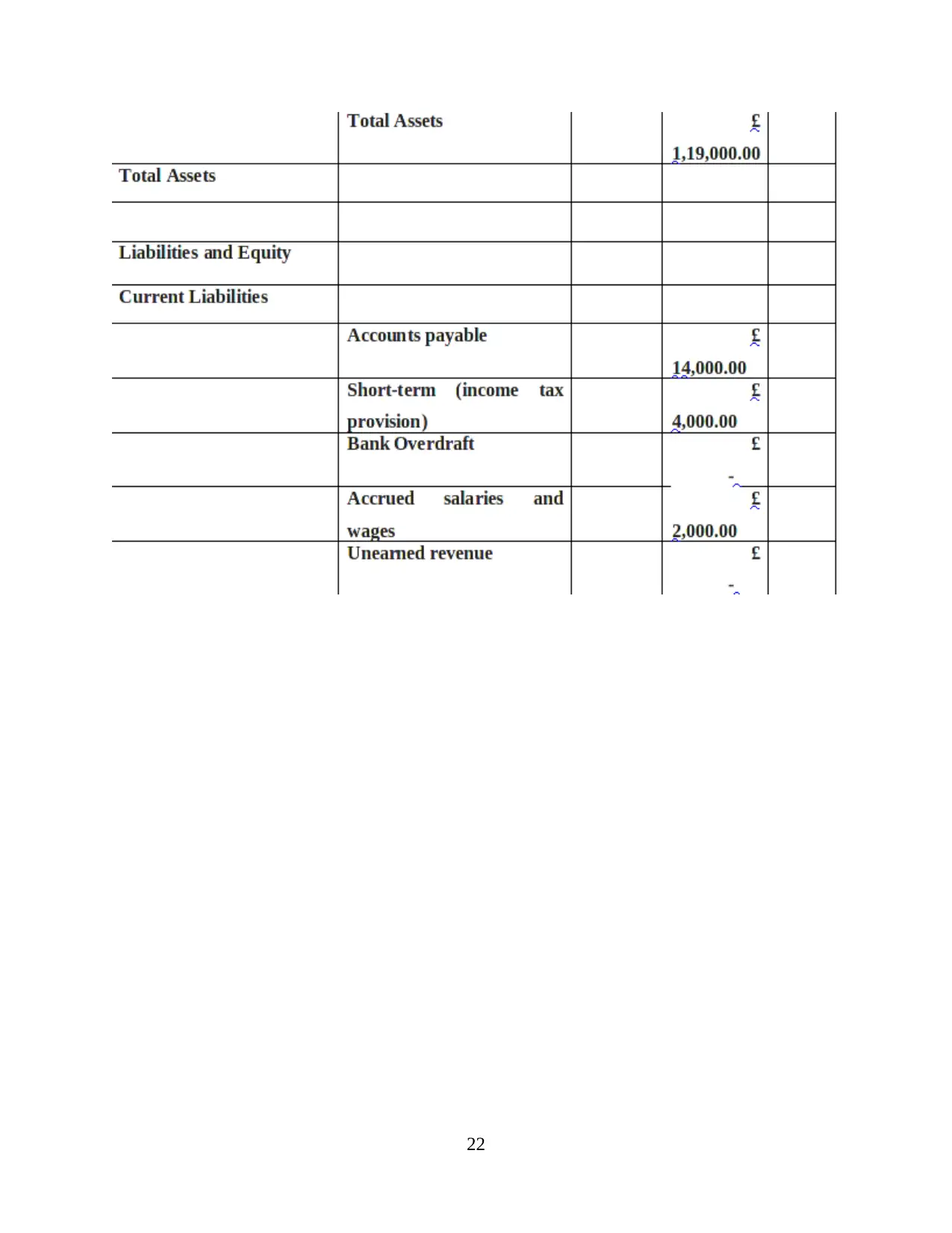
22
Paraphrase This Document
Need a fresh take? Get an instant paraphrase of this document with our AI Paraphraser
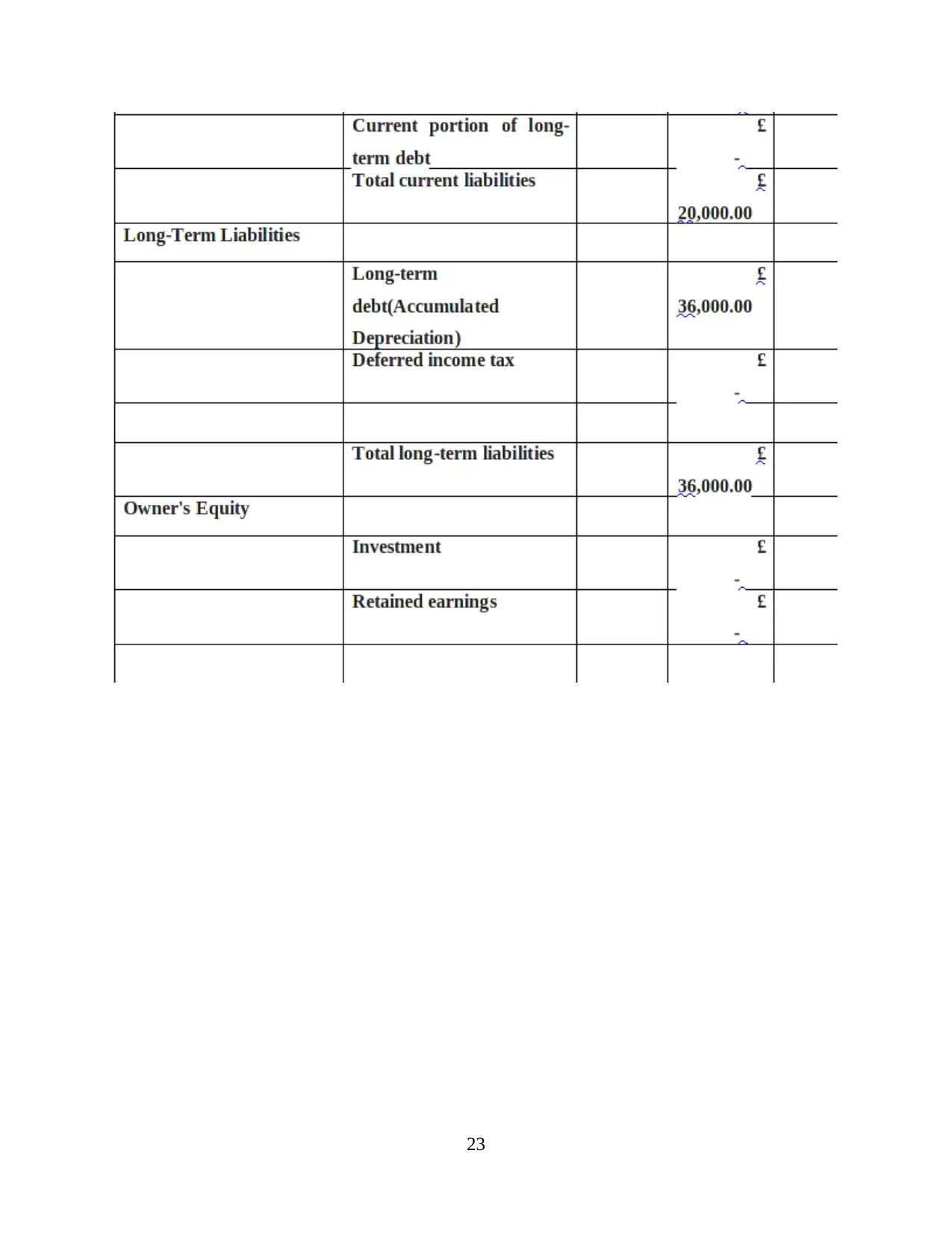
23
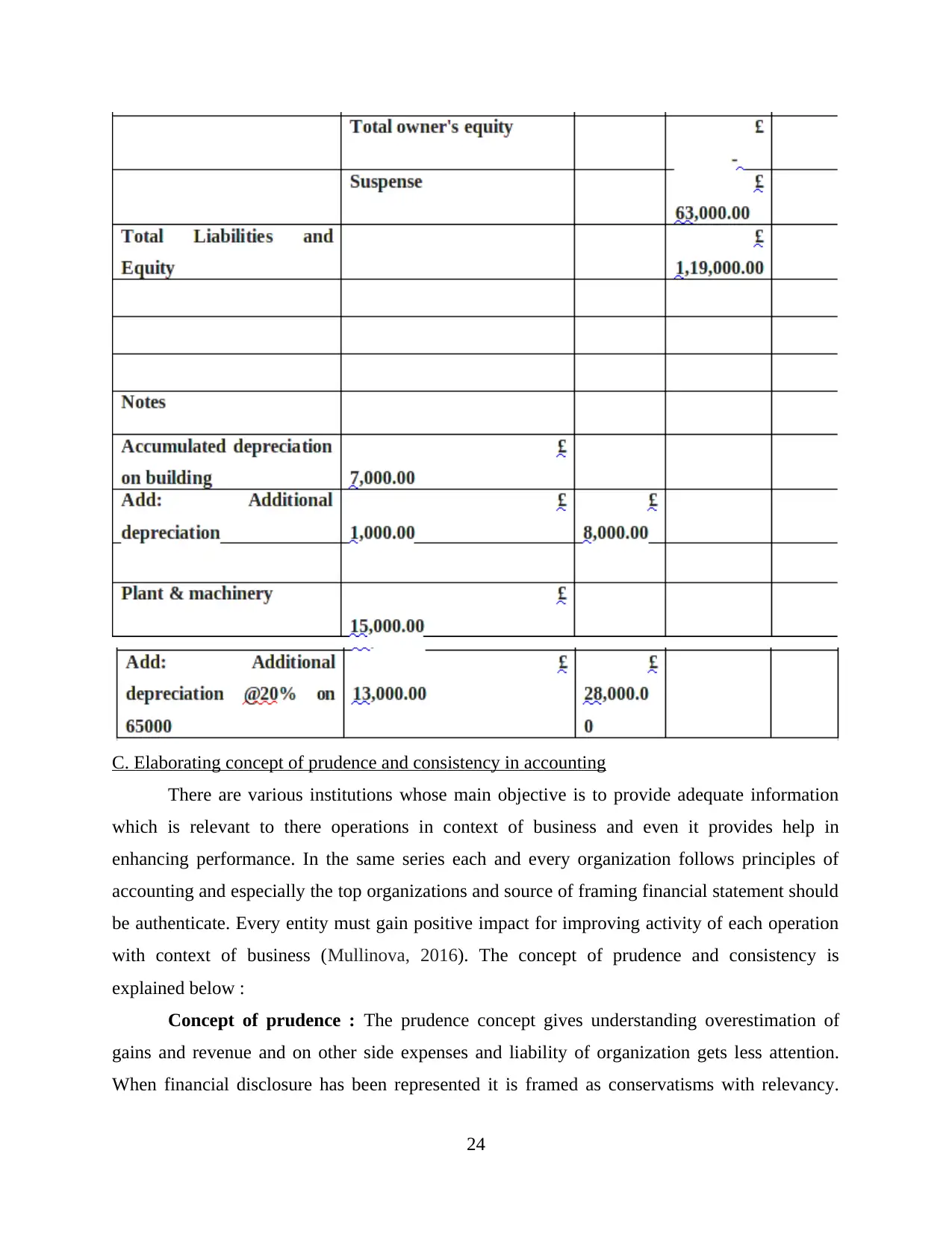
C. Elaborating concept of prudence and consistency in accounting
There are various institutions whose main objective is to provide adequate information
which is relevant to there operations in context of business and even it provides help in
enhancing performance. In the same series each and every organization follows principles of
accounting and especially the top organizations and source of framing financial statement should
be authenticate. Every entity must gain positive impact for improving activity of each operation
with context of business (Mullinova, 2016). The concept of prudence and consistency is
explained below :
Concept of prudence : The prudence concept gives understanding overestimation of
gains and revenue and on other side expenses and liability of organization gets less attention.
When financial disclosure has been represented it is framed as conservatisms with relevancy.
24
There are various institutions whose main objective is to provide adequate information
which is relevant to there operations in context of business and even it provides help in
enhancing performance. In the same series each and every organization follows principles of
accounting and especially the top organizations and source of framing financial statement should
be authenticate. Every entity must gain positive impact for improving activity of each operation
with context of business (Mullinova, 2016). The concept of prudence and consistency is
explained below :
Concept of prudence : The prudence concept gives understanding overestimation of
gains and revenue and on other side expenses and liability of organization gets less attention.
When financial disclosure has been represented it is framed as conservatisms with relevancy.
24
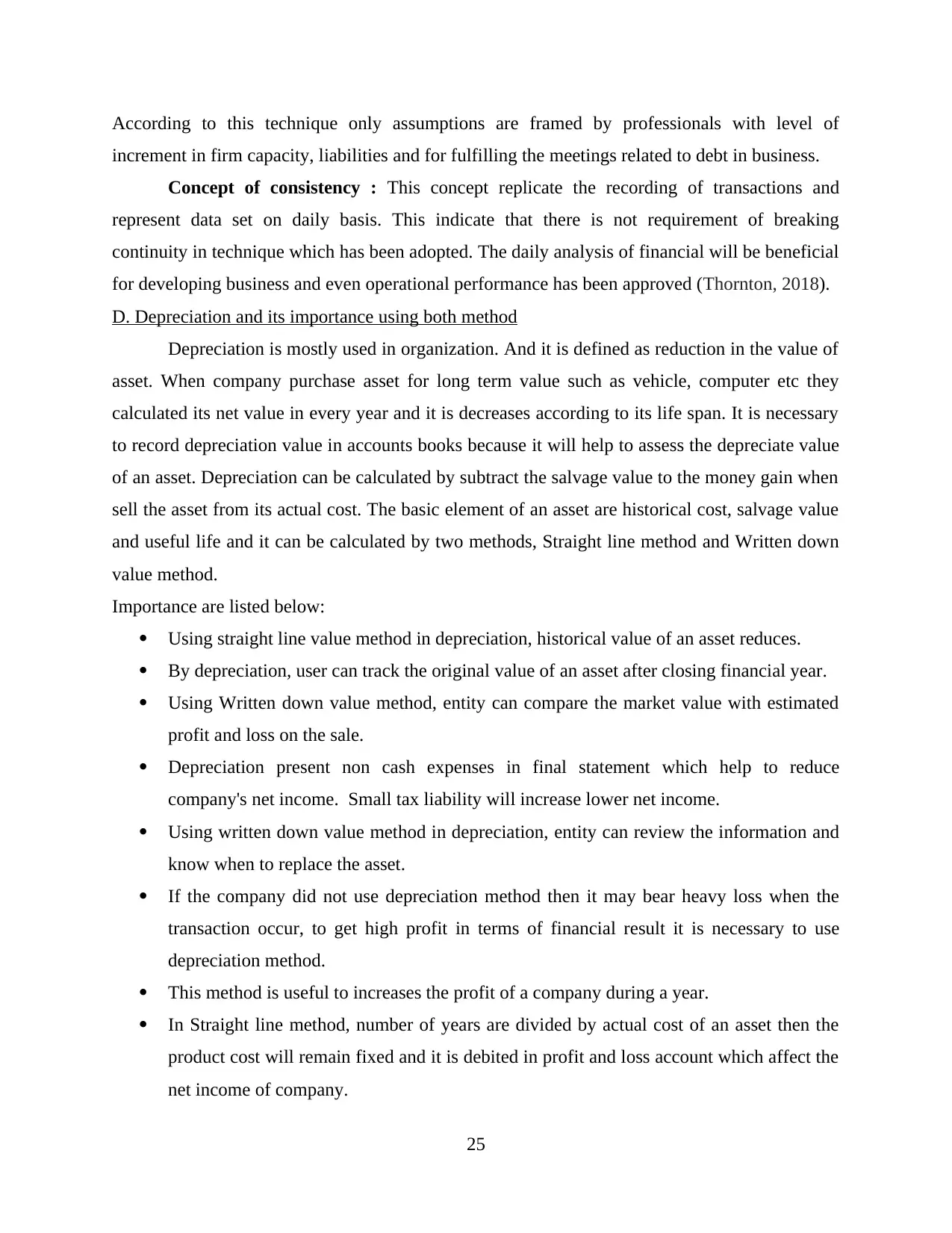
According to this technique only assumptions are framed by professionals with level of
increment in firm capacity, liabilities and for fulfilling the meetings related to debt in business.
Concept of consistency : This concept replicate the recording of transactions and
represent data set on daily basis. This indicate that there is not requirement of breaking
continuity in technique which has been adopted. The daily analysis of financial will be beneficial
for developing business and even operational performance has been approved (Thornton, 2018).
D. Depreciation and its importance using both method
Depreciation is mostly used in organization. And it is defined as reduction in the value of
asset. When company purchase asset for long term value such as vehicle, computer etc they
calculated its net value in every year and it is decreases according to its life span. It is necessary
to record depreciation value in accounts books because it will help to assess the depreciate value
of an asset. Depreciation can be calculated by subtract the salvage value to the money gain when
sell the asset from its actual cost. The basic element of an asset are historical cost, salvage value
and useful life and it can be calculated by two methods, Straight line method and Written down
value method.
Importance are listed below:
Using straight line value method in depreciation, historical value of an asset reduces.
By depreciation, user can track the original value of an asset after closing financial year.
Using Written down value method, entity can compare the market value with estimated
profit and loss on the sale.
Depreciation present non cash expenses in final statement which help to reduce
company's net income. Small tax liability will increase lower net income.
Using written down value method in depreciation, entity can review the information and
know when to replace the asset.
If the company did not use depreciation method then it may bear heavy loss when the
transaction occur, to get high profit in terms of financial result it is necessary to use
depreciation method.
This method is useful to increases the profit of a company during a year.
In Straight line method, number of years are divided by actual cost of an asset then the
product cost will remain fixed and it is debited in profit and loss account which affect the
net income of company.
25
increment in firm capacity, liabilities and for fulfilling the meetings related to debt in business.
Concept of consistency : This concept replicate the recording of transactions and
represent data set on daily basis. This indicate that there is not requirement of breaking
continuity in technique which has been adopted. The daily analysis of financial will be beneficial
for developing business and even operational performance has been approved (Thornton, 2018).
D. Depreciation and its importance using both method
Depreciation is mostly used in organization. And it is defined as reduction in the value of
asset. When company purchase asset for long term value such as vehicle, computer etc they
calculated its net value in every year and it is decreases according to its life span. It is necessary
to record depreciation value in accounts books because it will help to assess the depreciate value
of an asset. Depreciation can be calculated by subtract the salvage value to the money gain when
sell the asset from its actual cost. The basic element of an asset are historical cost, salvage value
and useful life and it can be calculated by two methods, Straight line method and Written down
value method.
Importance are listed below:
Using straight line value method in depreciation, historical value of an asset reduces.
By depreciation, user can track the original value of an asset after closing financial year.
Using Written down value method, entity can compare the market value with estimated
profit and loss on the sale.
Depreciation present non cash expenses in final statement which help to reduce
company's net income. Small tax liability will increase lower net income.
Using written down value method in depreciation, entity can review the information and
know when to replace the asset.
If the company did not use depreciation method then it may bear heavy loss when the
transaction occur, to get high profit in terms of financial result it is necessary to use
depreciation method.
This method is useful to increases the profit of a company during a year.
In Straight line method, number of years are divided by actual cost of an asset then the
product cost will remain fixed and it is debited in profit and loss account which affect the
net income of company.
25
Secure Best Marks with AI Grader
Need help grading? Try our AI Grader for instant feedback on your assignments.
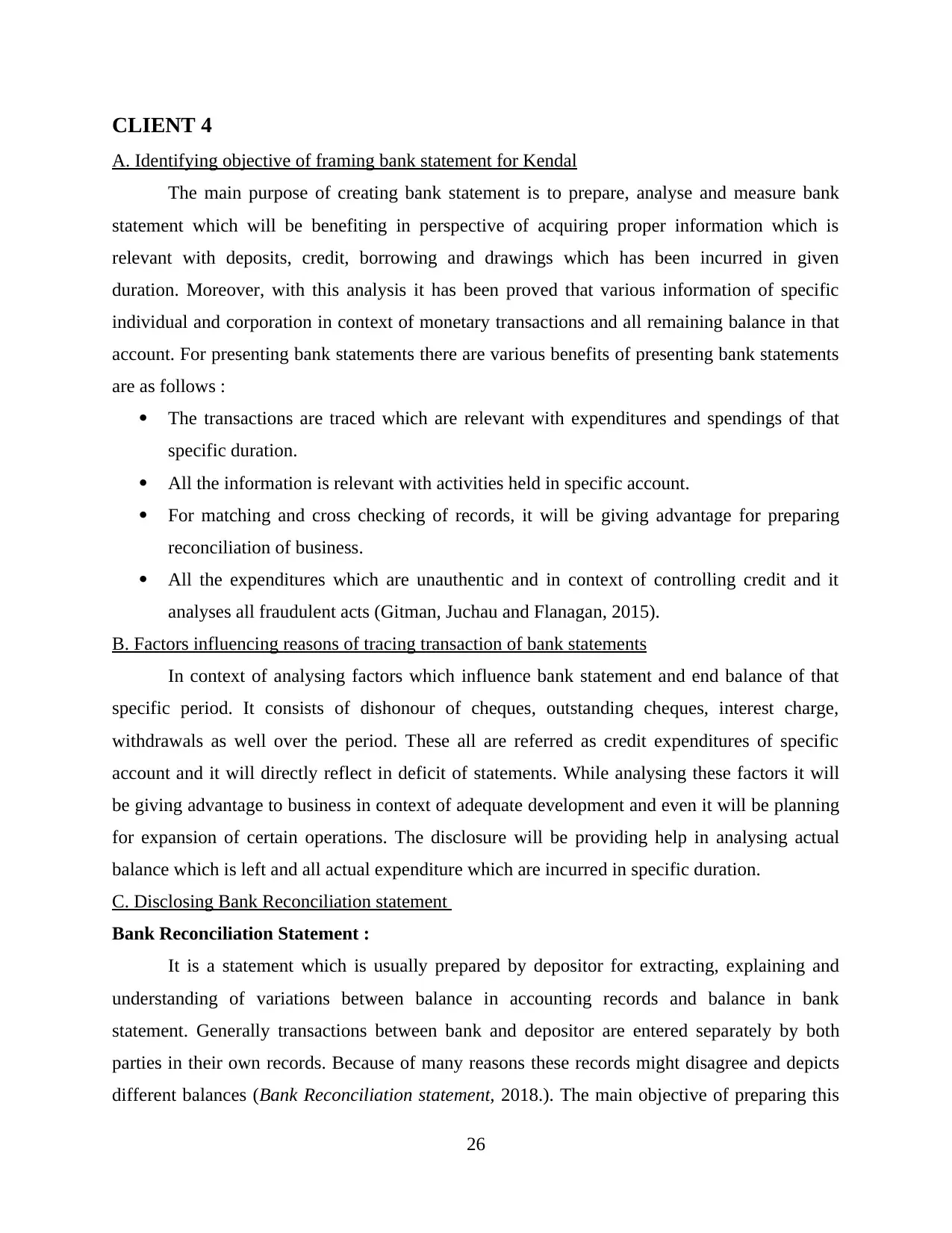
CLIENT 4
A. Identifying objective of framing bank statement for Kendal
The main purpose of creating bank statement is to prepare, analyse and measure bank
statement which will be benefiting in perspective of acquiring proper information which is
relevant with deposits, credit, borrowing and drawings which has been incurred in given
duration. Moreover, with this analysis it has been proved that various information of specific
individual and corporation in context of monetary transactions and all remaining balance in that
account. For presenting bank statements there are various benefits of presenting bank statements
are as follows :
The transactions are traced which are relevant with expenditures and spendings of that
specific duration.
All the information is relevant with activities held in specific account.
For matching and cross checking of records, it will be giving advantage for preparing
reconciliation of business.
All the expenditures which are unauthentic and in context of controlling credit and it
analyses all fraudulent acts (Gitman, Juchau and Flanagan, 2015).
B. Factors influencing reasons of tracing transaction of bank statements
In context of analysing factors which influence bank statement and end balance of that
specific period. It consists of dishonour of cheques, outstanding cheques, interest charge,
withdrawals as well over the period. These all are referred as credit expenditures of specific
account and it will directly reflect in deficit of statements. While analysing these factors it will
be giving advantage to business in context of adequate development and even it will be planning
for expansion of certain operations. The disclosure will be providing help in analysing actual
balance which is left and all actual expenditure which are incurred in specific duration.
C. Disclosing Bank Reconciliation statement
Bank Reconciliation Statement :
It is a statement which is usually prepared by depositor for extracting, explaining and
understanding of variations between balance in accounting records and balance in bank
statement. Generally transactions between bank and depositor are entered separately by both
parties in their own records. Because of many reasons these records might disagree and depicts
different balances (Bank Reconciliation statement, 2018.). The main objective of preparing this
26
A. Identifying objective of framing bank statement for Kendal
The main purpose of creating bank statement is to prepare, analyse and measure bank
statement which will be benefiting in perspective of acquiring proper information which is
relevant with deposits, credit, borrowing and drawings which has been incurred in given
duration. Moreover, with this analysis it has been proved that various information of specific
individual and corporation in context of monetary transactions and all remaining balance in that
account. For presenting bank statements there are various benefits of presenting bank statements
are as follows :
The transactions are traced which are relevant with expenditures and spendings of that
specific duration.
All the information is relevant with activities held in specific account.
For matching and cross checking of records, it will be giving advantage for preparing
reconciliation of business.
All the expenditures which are unauthentic and in context of controlling credit and it
analyses all fraudulent acts (Gitman, Juchau and Flanagan, 2015).
B. Factors influencing reasons of tracing transaction of bank statements
In context of analysing factors which influence bank statement and end balance of that
specific period. It consists of dishonour of cheques, outstanding cheques, interest charge,
withdrawals as well over the period. These all are referred as credit expenditures of specific
account and it will directly reflect in deficit of statements. While analysing these factors it will
be giving advantage to business in context of adequate development and even it will be planning
for expansion of certain operations. The disclosure will be providing help in analysing actual
balance which is left and all actual expenditure which are incurred in specific duration.
C. Disclosing Bank Reconciliation statement
Bank Reconciliation Statement :
It is a statement which is usually prepared by depositor for extracting, explaining and
understanding of variations between balance in accounting records and balance in bank
statement. Generally transactions between bank and depositor are entered separately by both
parties in their own records. Because of many reasons these records might disagree and depicts
different balances (Bank Reconciliation statement, 2018.). The main objective of preparing this
26
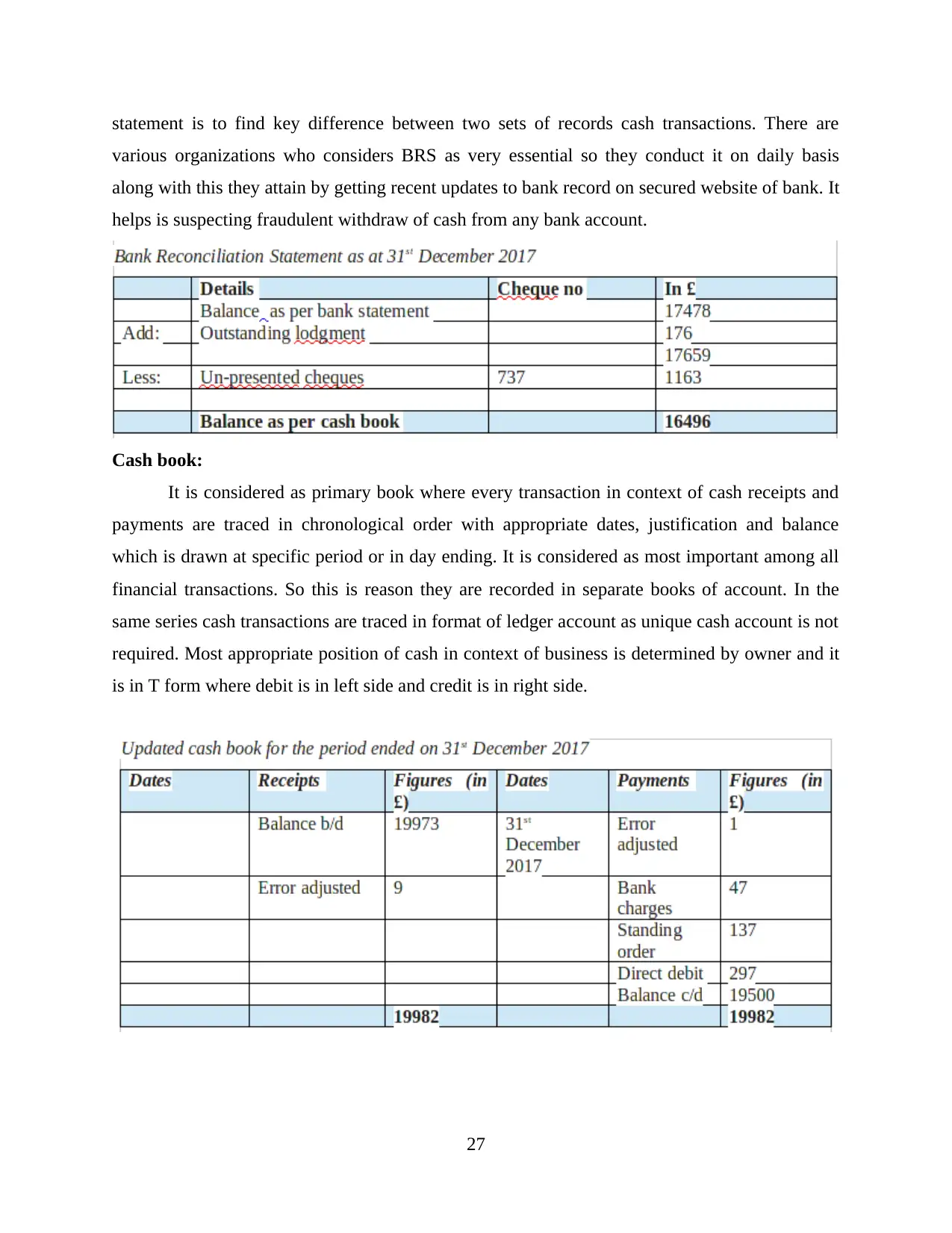
statement is to find key difference between two sets of records cash transactions. There are
various organizations who considers BRS as very essential so they conduct it on daily basis
along with this they attain by getting recent updates to bank record on secured website of bank. It
helps is suspecting fraudulent withdraw of cash from any bank account.
Cash book:
It is considered as primary book where every transaction in context of cash receipts and
payments are traced in chronological order with appropriate dates, justification and balance
which is drawn at specific period or in day ending. It is considered as most important among all
financial transactions. So this is reason they are recorded in separate books of account. In the
same series cash transactions are traced in format of ledger account as unique cash account is not
required. Most appropriate position of cash in context of business is determined by owner and it
is in T form where debit is in left side and credit is in right side.
27
various organizations who considers BRS as very essential so they conduct it on daily basis
along with this they attain by getting recent updates to bank record on secured website of bank. It
helps is suspecting fraudulent withdraw of cash from any bank account.
Cash book:
It is considered as primary book where every transaction in context of cash receipts and
payments are traced in chronological order with appropriate dates, justification and balance
which is drawn at specific period or in day ending. It is considered as most important among all
financial transactions. So this is reason they are recorded in separate books of account. In the
same series cash transactions are traced in format of ledger account as unique cash account is not
required. Most appropriate position of cash in context of business is determined by owner and it
is in T form where debit is in left side and credit is in right side.
27
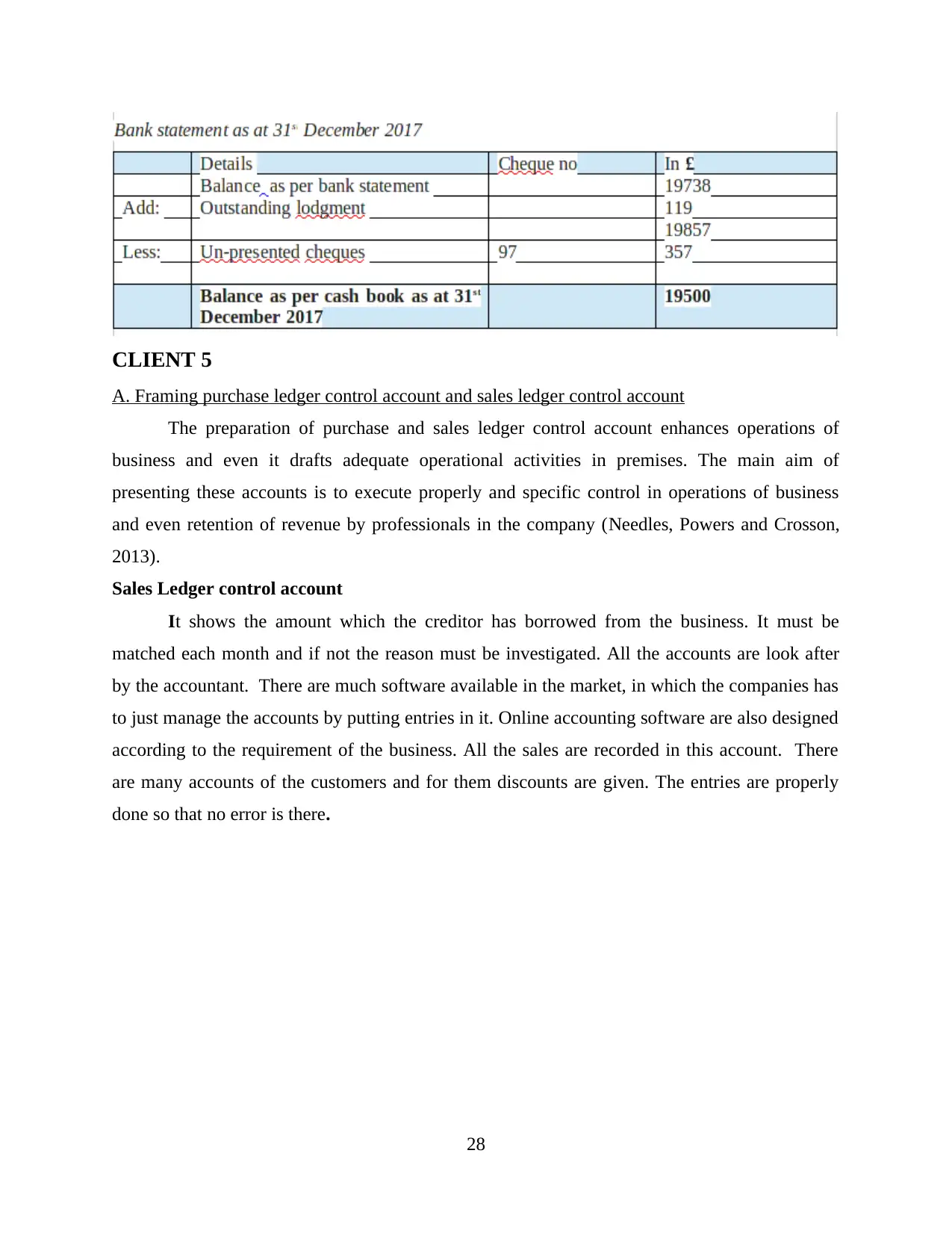
CLIENT 5
A. Framing purchase ledger control account and sales ledger control account
The preparation of purchase and sales ledger control account enhances operations of
business and even it drafts adequate operational activities in premises. The main aim of
presenting these accounts is to execute properly and specific control in operations of business
and even retention of revenue by professionals in the company (Needles, Powers and Crosson,
2013).
Sales Ledger control account
It shows the amount which the creditor has borrowed from the business. It must be
matched each month and if not the reason must be investigated. All the accounts are look after
by the accountant. There are much software available in the market, in which the companies has
to just manage the accounts by putting entries in it. Online accounting software are also designed
according to the requirement of the business. All the sales are recorded in this account. There
are many accounts of the customers and for them discounts are given. The entries are properly
done so that no error is there.
28
A. Framing purchase ledger control account and sales ledger control account
The preparation of purchase and sales ledger control account enhances operations of
business and even it drafts adequate operational activities in premises. The main aim of
presenting these accounts is to execute properly and specific control in operations of business
and even retention of revenue by professionals in the company (Needles, Powers and Crosson,
2013).
Sales Ledger control account
It shows the amount which the creditor has borrowed from the business. It must be
matched each month and if not the reason must be investigated. All the accounts are look after
by the accountant. There are much software available in the market, in which the companies has
to just manage the accounts by putting entries in it. Online accounting software are also designed
according to the requirement of the business. All the sales are recorded in this account. There
are many accounts of the customers and for them discounts are given. The entries are properly
done so that no error is there.
28
Paraphrase This Document
Need a fresh take? Get an instant paraphrase of this document with our AI Paraphraser

Purchase Ledger control account:
It is also known as the trade creditor account. Debtor and creditor both has control over it.
Both the controllers make sure that no errors prevail in the ledger. Both must have the same
balance. Matching balance shows that the account is correct with all the entries. In accounting
the ledger is made after journal. Person who is authorised to do the checking of accounts must
see that totalling of general ledger and control account must match. It is also known as
reconciliation. Much software are there in which entries are easily manageable.
B. Justifying need of framing control account
Control account has been prepared which identifies every department in the organization.
It can be justified by its name that accounts should be executed and it should be controlled by
different professionals in context of making very strong decisions which will be giving
advantage for analysing cost and gain of business in specific duration (Control Accounts, 2018).
Usually these accounts are prepared and measured by huge organization for extracting
information which is relevant with operations of every unit like purchase, sales, production,
marketing etc. and it will be represented as very helpful tool for framing adequate estimation of
performance of business. It is summarized format of general ledger as it consists of sum of every
transactions which are separated individually in subsidiary account of ledger.
29
It is also known as the trade creditor account. Debtor and creditor both has control over it.
Both the controllers make sure that no errors prevail in the ledger. Both must have the same
balance. Matching balance shows that the account is correct with all the entries. In accounting
the ledger is made after journal. Person who is authorised to do the checking of accounts must
see that totalling of general ledger and control account must match. It is also known as
reconciliation. Much software are there in which entries are easily manageable.
B. Justifying need of framing control account
Control account has been prepared which identifies every department in the organization.
It can be justified by its name that accounts should be executed and it should be controlled by
different professionals in context of making very strong decisions which will be giving
advantage for analysing cost and gain of business in specific duration (Control Accounts, 2018).
Usually these accounts are prepared and measured by huge organization for extracting
information which is relevant with operations of every unit like purchase, sales, production,
marketing etc. and it will be represented as very helpful tool for framing adequate estimation of
performance of business. It is summarized format of general ledger as it consists of sum of every
transactions which are separated individually in subsidiary account of ledger.
29
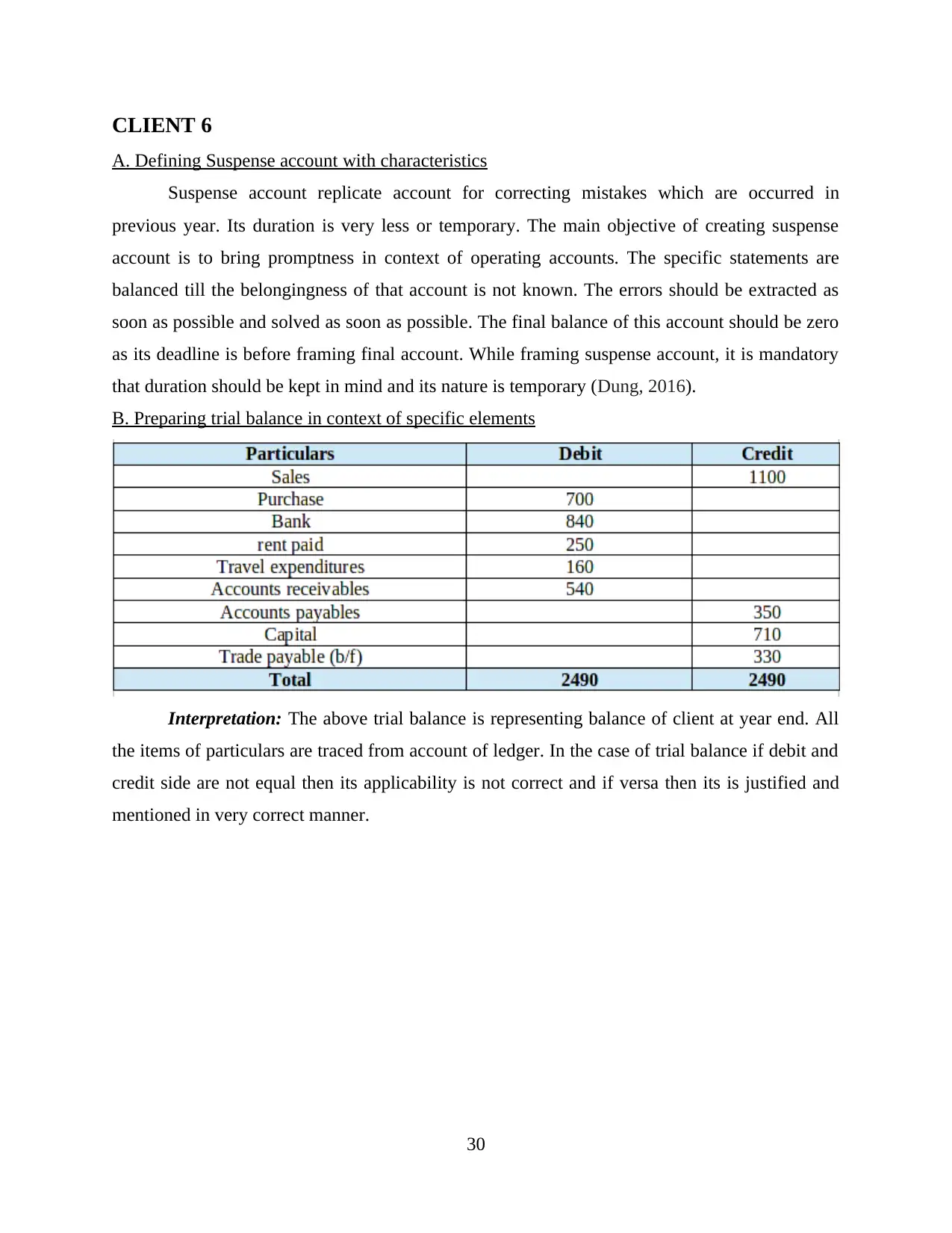
CLIENT 6
A. Defining Suspense account with characteristics
Suspense account replicate account for correcting mistakes which are occurred in
previous year. Its duration is very less or temporary. The main objective of creating suspense
account is to bring promptness in context of operating accounts. The specific statements are
balanced till the belongingness of that account is not known. The errors should be extracted as
soon as possible and solved as soon as possible. The final balance of this account should be zero
as its deadline is before framing final account. While framing suspense account, it is mandatory
that duration should be kept in mind and its nature is temporary (Dung, 2016).
B. Preparing trial balance in context of specific elements
Interpretation: The above trial balance is representing balance of client at year end. All
the items of particulars are traced from account of ledger. In the case of trial balance if debit and
credit side are not equal then its applicability is not correct and if versa then its is justified and
mentioned in very correct manner.
30
A. Defining Suspense account with characteristics
Suspense account replicate account for correcting mistakes which are occurred in
previous year. Its duration is very less or temporary. The main objective of creating suspense
account is to bring promptness in context of operating accounts. The specific statements are
balanced till the belongingness of that account is not known. The errors should be extracted as
soon as possible and solved as soon as possible. The final balance of this account should be zero
as its deadline is before framing final account. While framing suspense account, it is mandatory
that duration should be kept in mind and its nature is temporary (Dung, 2016).
B. Preparing trial balance in context of specific elements
Interpretation: The above trial balance is representing balance of client at year end. All
the items of particulars are traced from account of ledger. In the case of trial balance if debit and
credit side are not equal then its applicability is not correct and if versa then its is justified and
mentioned in very correct manner.
30
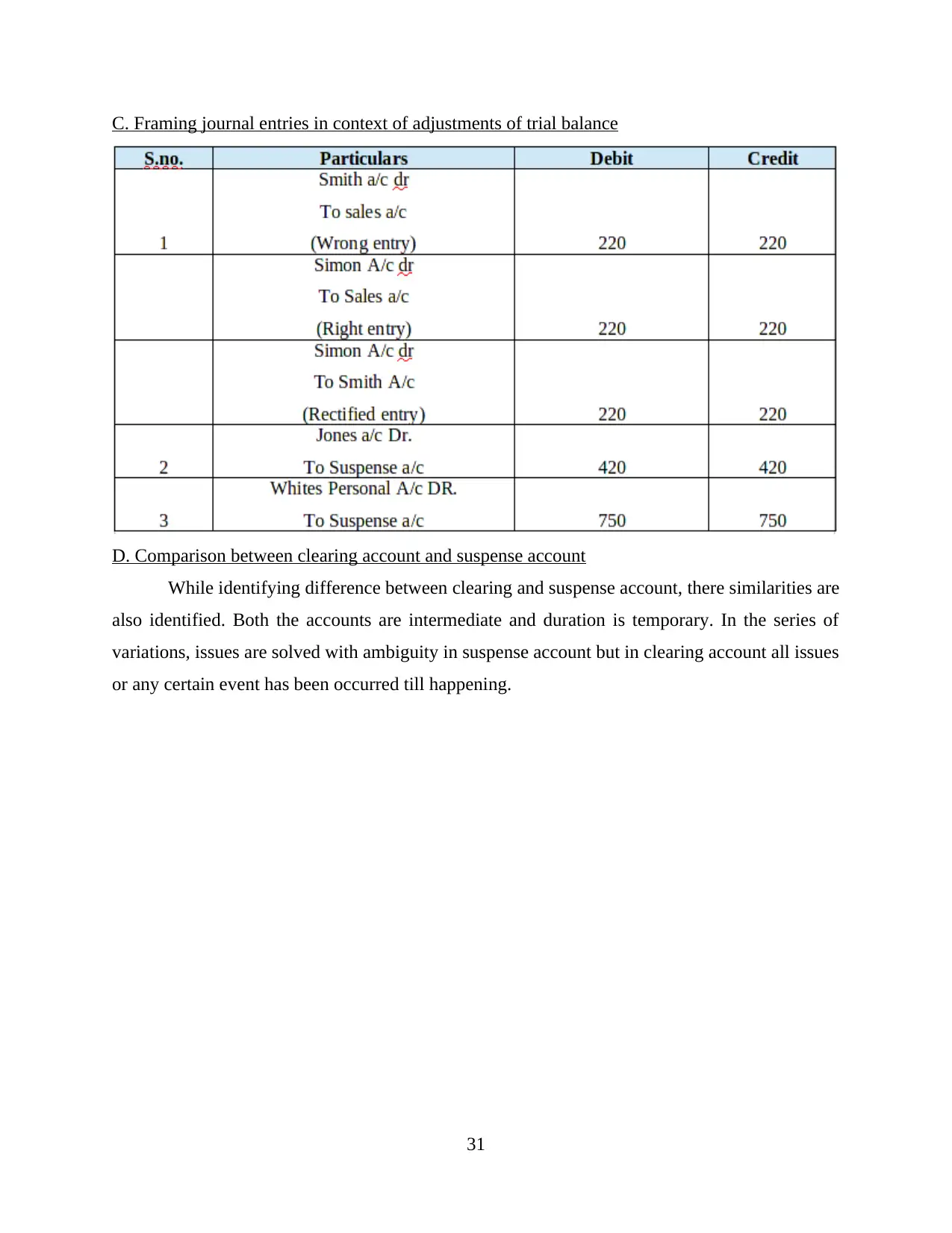
C. Framing journal entries in context of adjustments of trial balance
D. Comparison between clearing account and suspense account
While identifying difference between clearing and suspense account, there similarities are
also identified. Both the accounts are intermediate and duration is temporary. In the series of
variations, issues are solved with ambiguity in suspense account but in clearing account all issues
or any certain event has been occurred till happening.
31
D. Comparison between clearing account and suspense account
While identifying difference between clearing and suspense account, there similarities are
also identified. Both the accounts are intermediate and duration is temporary. In the series of
variations, issues are solved with ambiguity in suspense account but in clearing account all issues
or any certain event has been occurred till happening.
31
Secure Best Marks with AI Grader
Need help grading? Try our AI Grader for instant feedback on your assignments.
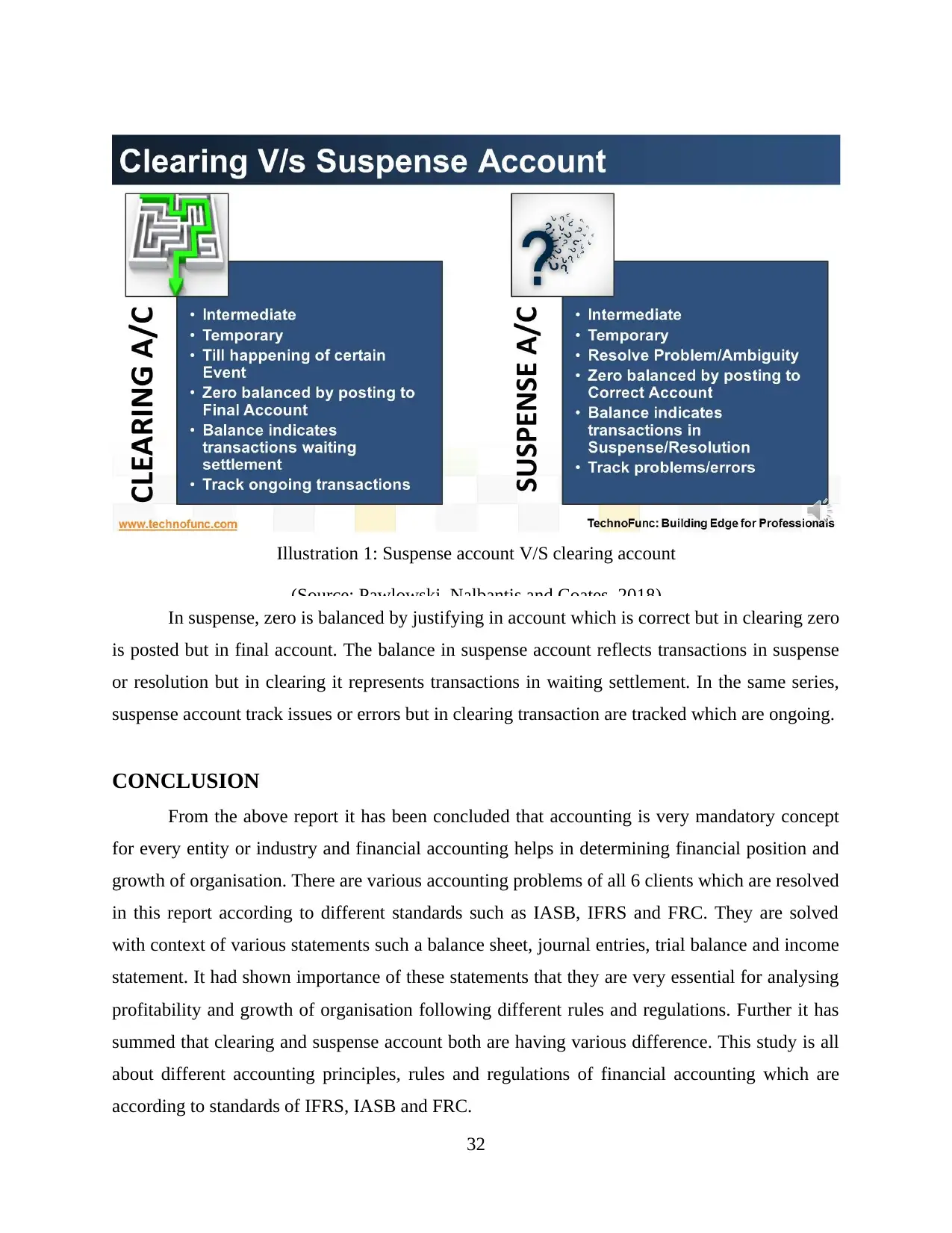
Illustration 1: Suspense account V/S clearing account
(Source: Pawlowski, Nalbantis and Coates, 2018)
In suspense, zero is balanced by justifying in account which is correct but in clearing zero
is posted but in final account. The balance in suspense account reflects transactions in suspense
or resolution but in clearing it represents transactions in waiting settlement. In the same series,
suspense account track issues or errors but in clearing transaction are tracked which are ongoing.
CONCLUSION
From the above report it has been concluded that accounting is very mandatory concept
for every entity or industry and financial accounting helps in determining financial position and
growth of organisation. There are various accounting problems of all 6 clients which are resolved
in this report according to different standards such as IASB, IFRS and FRC. They are solved
with context of various statements such a balance sheet, journal entries, trial balance and income
statement. It had shown importance of these statements that they are very essential for analysing
profitability and growth of organisation following different rules and regulations. Further it has
summed that clearing and suspense account both are having various difference. This study is all
about different accounting principles, rules and regulations of financial accounting which are
according to standards of IFRS, IASB and FRC.
32
(Source: Pawlowski, Nalbantis and Coates, 2018)
In suspense, zero is balanced by justifying in account which is correct but in clearing zero
is posted but in final account. The balance in suspense account reflects transactions in suspense
or resolution but in clearing it represents transactions in waiting settlement. In the same series,
suspense account track issues or errors but in clearing transaction are tracked which are ongoing.
CONCLUSION
From the above report it has been concluded that accounting is very mandatory concept
for every entity or industry and financial accounting helps in determining financial position and
growth of organisation. There are various accounting problems of all 6 clients which are resolved
in this report according to different standards such as IASB, IFRS and FRC. They are solved
with context of various statements such a balance sheet, journal entries, trial balance and income
statement. It had shown importance of these statements that they are very essential for analysing
profitability and growth of organisation following different rules and regulations. Further it has
summed that clearing and suspense account both are having various difference. This study is all
about different accounting principles, rules and regulations of financial accounting which are
according to standards of IFRS, IASB and FRC.
32

REFERENCES
Books and Journals
Dung, N. V., 2016. Value-relevance of financial statement information: A flexible application of
modern theories to the Vietnamese stock market. Quarterly Journal of Economics. 84.
pp.488-500.
Gitman, L.J., Juchau, R. and Flanagan, J., 2015. Principles of managerial finance. Pearson
Higher Education AU.
Li, S., Sougiannis, T. and Wang, I., 2017. Mandatory IFRS Adoption and the Usefulness of
Accounting Information in Predicting Future Earnings and Cash Flows.
McLaren, M., 2018. ‘Evidence-based policy-making’: a practitioner view. Accounting and
Business Research. 48(5). pp.609-611.
Mullinova, S., 2016. Use of the principles of IFRS (IAS) 39" Financial instruments: recognition
and assessment" for bank financial accounting. Modern European Researches. (1). pp.60-
64.
Needles, B. E., Powers, M. and Crosson, S. V., 2013. Principles of accounting. Cengage
Learning.
Ombati, R. and Shukla, A., 2018. Analyzing the problems with the current adoption of IFRS in
the companies among India, China, Germany, Russia and Kenya. Accounting. 4(1). pp.29-
40.
Pawlowski, T., Nalbantis, G. and Coates, D., 2018. Perceived game uncertainty, suspense and
the demand for sport. Economic Inquiry. 56(1). pp.173-192.
Thornton, S. C., 2018. A Collection of Case Studies on Financial Accounting Concepts (Doctoral
dissertation, University of Mississippi).
Trucco, S., 2015. Premises for the Convergence of Financial Accounting and Management
Accounting. In Financial Accounting (pp. 41-64). Springer, Cham.
Weygandt, J. J., Kimmel, P. D. and Kieso, D. E., 2015. Financial & managerial accounting.
John Wiley & Sons.
ONLINE
Bank Reconciliation statement. 2018. [Online]. Available through
:<https://www.accountingtools.com/articles/what-is-the-purpose-of-a-bank-
reconciliation.html>.
33
Books and Journals
Dung, N. V., 2016. Value-relevance of financial statement information: A flexible application of
modern theories to the Vietnamese stock market. Quarterly Journal of Economics. 84.
pp.488-500.
Gitman, L.J., Juchau, R. and Flanagan, J., 2015. Principles of managerial finance. Pearson
Higher Education AU.
Li, S., Sougiannis, T. and Wang, I., 2017. Mandatory IFRS Adoption and the Usefulness of
Accounting Information in Predicting Future Earnings and Cash Flows.
McLaren, M., 2018. ‘Evidence-based policy-making’: a practitioner view. Accounting and
Business Research. 48(5). pp.609-611.
Mullinova, S., 2016. Use of the principles of IFRS (IAS) 39" Financial instruments: recognition
and assessment" for bank financial accounting. Modern European Researches. (1). pp.60-
64.
Needles, B. E., Powers, M. and Crosson, S. V., 2013. Principles of accounting. Cengage
Learning.
Ombati, R. and Shukla, A., 2018. Analyzing the problems with the current adoption of IFRS in
the companies among India, China, Germany, Russia and Kenya. Accounting. 4(1). pp.29-
40.
Pawlowski, T., Nalbantis, G. and Coates, D., 2018. Perceived game uncertainty, suspense and
the demand for sport. Economic Inquiry. 56(1). pp.173-192.
Thornton, S. C., 2018. A Collection of Case Studies on Financial Accounting Concepts (Doctoral
dissertation, University of Mississippi).
Trucco, S., 2015. Premises for the Convergence of Financial Accounting and Management
Accounting. In Financial Accounting (pp. 41-64). Springer, Cham.
Weygandt, J. J., Kimmel, P. D. and Kieso, D. E., 2015. Financial & managerial accounting.
John Wiley & Sons.
ONLINE
Bank Reconciliation statement. 2018. [Online]. Available through
:<https://www.accountingtools.com/articles/what-is-the-purpose-of-a-bank-
reconciliation.html>.
33
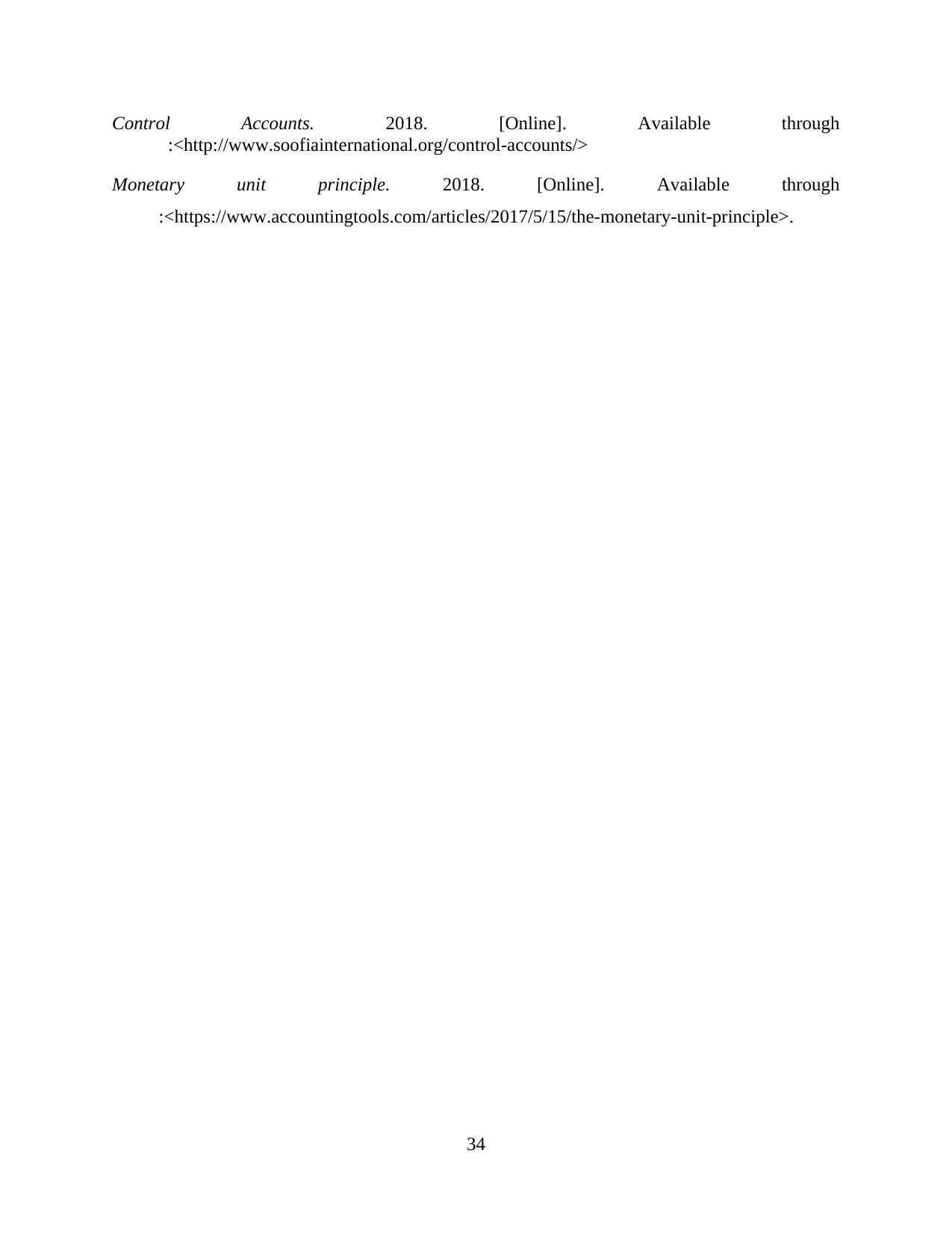
Control Accounts. 2018. [Online]. Available through
:<http://www.soofiainternational.org/control-accounts/>
Monetary unit principle. 2018. [Online]. Available through
:<https://www.accountingtools.com/articles/2017/5/15/the-monetary-unit-principle>.
34
:<http://www.soofiainternational.org/control-accounts/>
Monetary unit principle. 2018. [Online]. Available through
:<https://www.accountingtools.com/articles/2017/5/15/the-monetary-unit-principle>.
34
1 out of 37
Related Documents
Your All-in-One AI-Powered Toolkit for Academic Success.
+13062052269
info@desklib.com
Available 24*7 on WhatsApp / Email
![[object Object]](/_next/static/media/star-bottom.7253800d.svg)
Unlock your academic potential
© 2024 | Zucol Services PVT LTD | All rights reserved.





